T.S. Rhodes's Blog, page 10
May 23, 2016
The Port Washington Pirate Festival
June 3-5 in Port Washington Wisconsin [image error]It’s hard being a 21stcentury, modern day pirate. Any way you look at it, the ocean is roughly 1,500 miles away. And, if you’re as close to Chicago as I am, the weather is hardly tropical. But these terrible problems have been mitigated by wonderful reinstatement.
The Port Washington Pirate Festival is back!

Port Washington was my first pirate festival, and it became a yearly ritual. Situated beside the wide waters of Lake Michigan, in the picturesque resort town of Port Washington, the festival was lively, colorful, and full of interesting people. It introduced me to pirate rock and pirate folk music. It provided my first cruise on a tall ship. And, while dressing for one of the events, I had the revelation that ultimately revealed the character of Scarlet MacGrath, the pirate heroine of my novel series.
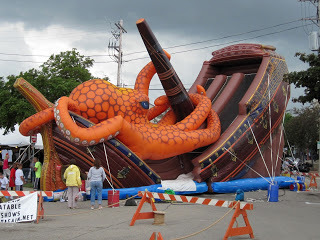
The pirate festival was free. On our first visit, we visited on the cheap, by staying at a local campground. In future years, we opted for each of a variety of low-cost local motels – several of which are nearby. Port Washington also offers a high-rise Holiday Inn, situated right next to the action.
Port Washington is a small town, and the festival takes place on a lovely strip of land between picturesque buildings and the wide expanse of the historic port. Local fishing boats, decorated with pirate accoutrements, bob in the waves. A gazebo sheltered singers and musicians.
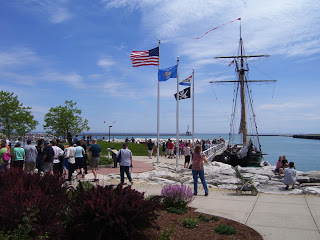
The fest’s organizers also invited historical reenactors to set up an encampment, where visitors could learn about real 18th century life, from blacksmithing to waving to recreational ax-throwing. The reenactors also provided a small troop of redcoats for the pirates to harass.
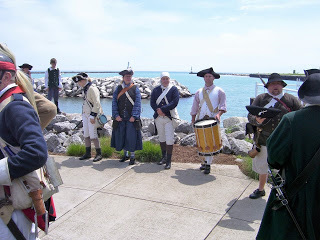
The festival, in true pirate fashion, provided a Buccaneers Bash on Friday night, with a tent full of music and loud music. On Saturday, the tall ship (Windy II during my first time at the fest) sailed into the harbor with black powder cannons blazing. The “governor” made a speech, the pirates kidnapped his daughter, and subsequently “negotiated” for a weekend long free pardon for all the pirates. Much cheering. Toasts of rum.

The body of the fest was pirate acts – mostly musical – and a “thieves’ marketplace” for vendors. I will say that the variety of vendors covered a lot of ground. Exotic carved wooden folk art from Thailand, pirate garb vendors, arms merchants (of the 18thcentury variety) mingled with jewelry, kid’s trinkets, and a variety of other crafty type wares.

Vendors claim to have all done well. The only exception? A soap merchant. Soap and pirates… maybe this one was doomed from the start.
The good ship Windy II offered cruises starting at about $30. For additional fees, guests could be aboard during the Saturday morning “attack” on the port, or during dinnertime (with a meal) and late Saturday night, when the fireworks were let off. Fireworks over a pirate event. Truly grand.

In between the educational events, (is sampling historically accurate grog research?) and listening to electric guitars belt out sea shanties, the people-watching was prime. Small children dressed in finery from the Disney Store, reenactors who had slaved over their wool and linen garb for dozens – if not hundreds – of hours, moms who grabbed a pattern from Simplicity and a dozen yards of stripped fabric, and biker-types who dress like this every day and are just a little scary-looking. But it was a friendly group - everyone happy. And why not? We were pirates!

I spent many happy hours wandering through this wonderful event. I even like to think I contributed to it – when the committee asked for suggestions, I told them that they needed belly dancers. Belly dancers and pirates are two great things that go great together. (Even better than peanut butter and chocolate.) The very next year, a troop of belly dancers appeared.

And then… it disappeared. A notice went up, and the Port Washington Pirate Festival was no more. For three long years, the pirates in the Midwest had to do without.

But this year the festival is back! Under new management, with limited resources it’s true, but back. The belly dancers. The tall ship (not the Windy II, but a historic vessel, the Denis Sullivan will be offering cruises – for a fee, I’m sure. The belly dancers are back. And I’ll be doing my part, spinning pirate tales, exploring the secrets inside a pirate chest, and autographing copies of my books.
So, if you are in the Midwest on the first weekend in June – that’s June 3,4 and 5 this year, come one up to Port Royal and have a good time.

Yes, all these pictures are actually from the fest.
The Port Washington Pirate Festival is back!

Port Washington was my first pirate festival, and it became a yearly ritual. Situated beside the wide waters of Lake Michigan, in the picturesque resort town of Port Washington, the festival was lively, colorful, and full of interesting people. It introduced me to pirate rock and pirate folk music. It provided my first cruise on a tall ship. And, while dressing for one of the events, I had the revelation that ultimately revealed the character of Scarlet MacGrath, the pirate heroine of my novel series.

The pirate festival was free. On our first visit, we visited on the cheap, by staying at a local campground. In future years, we opted for each of a variety of low-cost local motels – several of which are nearby. Port Washington also offers a high-rise Holiday Inn, situated right next to the action.
Port Washington is a small town, and the festival takes place on a lovely strip of land between picturesque buildings and the wide expanse of the historic port. Local fishing boats, decorated with pirate accoutrements, bob in the waves. A gazebo sheltered singers and musicians.

The fest’s organizers also invited historical reenactors to set up an encampment, where visitors could learn about real 18th century life, from blacksmithing to waving to recreational ax-throwing. The reenactors also provided a small troop of redcoats for the pirates to harass.

The festival, in true pirate fashion, provided a Buccaneers Bash on Friday night, with a tent full of music and loud music. On Saturday, the tall ship (Windy II during my first time at the fest) sailed into the harbor with black powder cannons blazing. The “governor” made a speech, the pirates kidnapped his daughter, and subsequently “negotiated” for a weekend long free pardon for all the pirates. Much cheering. Toasts of rum.

The body of the fest was pirate acts – mostly musical – and a “thieves’ marketplace” for vendors. I will say that the variety of vendors covered a lot of ground. Exotic carved wooden folk art from Thailand, pirate garb vendors, arms merchants (of the 18thcentury variety) mingled with jewelry, kid’s trinkets, and a variety of other crafty type wares.

Vendors claim to have all done well. The only exception? A soap merchant. Soap and pirates… maybe this one was doomed from the start.
The good ship Windy II offered cruises starting at about $30. For additional fees, guests could be aboard during the Saturday morning “attack” on the port, or during dinnertime (with a meal) and late Saturday night, when the fireworks were let off. Fireworks over a pirate event. Truly grand.

In between the educational events, (is sampling historically accurate grog research?) and listening to electric guitars belt out sea shanties, the people-watching was prime. Small children dressed in finery from the Disney Store, reenactors who had slaved over their wool and linen garb for dozens – if not hundreds – of hours, moms who grabbed a pattern from Simplicity and a dozen yards of stripped fabric, and biker-types who dress like this every day and are just a little scary-looking. But it was a friendly group - everyone happy. And why not? We were pirates!

I spent many happy hours wandering through this wonderful event. I even like to think I contributed to it – when the committee asked for suggestions, I told them that they needed belly dancers. Belly dancers and pirates are two great things that go great together. (Even better than peanut butter and chocolate.) The very next year, a troop of belly dancers appeared.

And then… it disappeared. A notice went up, and the Port Washington Pirate Festival was no more. For three long years, the pirates in the Midwest had to do without.

But this year the festival is back! Under new management, with limited resources it’s true, but back. The belly dancers. The tall ship (not the Windy II, but a historic vessel, the Denis Sullivan will be offering cruises – for a fee, I’m sure. The belly dancers are back. And I’ll be doing my part, spinning pirate tales, exploring the secrets inside a pirate chest, and autographing copies of my books.
So, if you are in the Midwest on the first weekend in June – that’s June 3,4 and 5 this year, come one up to Port Royal and have a good time.

Yes, all these pictures are actually from the fest.
Published on May 23, 2016 18:51
May 16, 2016
The Story of Ben Gunn, Pirate
Treasure Island contains dozens of pirates – from Long John Silver, whom no one will ever forget, the George Merry, whom few remember. Stuck somewhere in the middle of the pack is Ben Gunn. A bad pirate but a good man, Ben is one of the characters that give Treasure Island its depth.
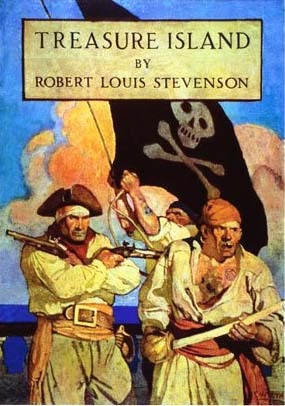
In the novel, Jim Hawkins stumbles across Ben after the pirates have mutinied and are searching the island for Flint’s treasure. Ben is a former pirate who was maroons on the island three years before. He had led a ship in search of the treasure. But without the map – formerly in the hands of Billy Bones and now possessed by Jim – the group was unable to locate the loot.
After 12 days of hunting, they sailed off, leaving Ben behind. Over the next three years, Ben keeps himself alive by catching wild goats. He builds himself a shelter and a small boat. Time on the island has caused him to reflect upon his life, so that he had decided to reform his life. But he has never ceased searching for the Flint’s treasure.
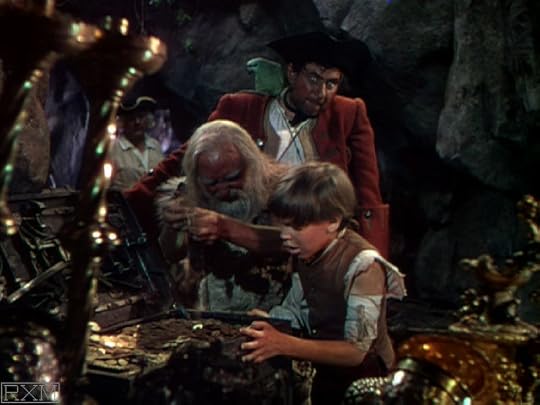
As a literary device, Ben provides plot twists, surprises, and even some comic relief. If it wasn’t for him, the story of Treasure Island would have played out much differently.
The character, like Robinson Caruso, was most likely based on Alexander Selkirk, a sailor who chose to stay on a lonely tropical island rather than go on is a leaky ship under poor leadership. Three years after being left behind, Selkirk was rescued by the same captain he had abandoned three years before.
Like Selkirk, Ben lives on goats, clothes himself in goatskin, and longs for cheese. This latter is especially interesting in light of recent discoveries that cheese might be considered an addictive substance.

In the book, Ben Gunn is a nobody. He is a little off-balance from his long, solitary stay on the island. He tries to help Jim and the rest of Jim’s company, but even his efforts to frighten the pirates with spooky moaning noises fail. At first the pirates believe it is the Ghost of Flint, and are terrified. But when Long John Silver recognizes the voice of Ben, the other pirates lose their fear, even if Ben is a ghost. To quote the pirate George Merry, "Nobody minds Ben Gunn [...] dead or alive, nobody minds him"
But Ben Gunn is an integral part of the famous tale, and he appears in all of the Treasure Island movies. Movies, however, provide a wider variety of expression, and Ben Gunn has been played by many different actors and in many different ways.
In some movies – in Disney’s famous version from 1950, Geoffrey Wilkinson plays Ben is just about what we’d expect – comic relief.
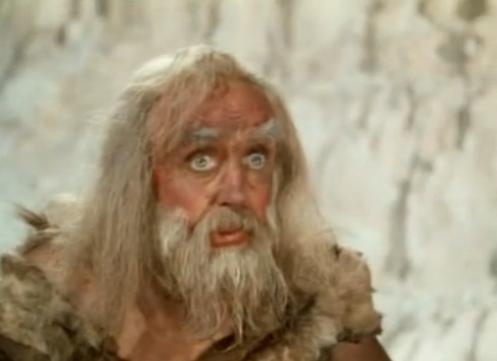
The Muppets, in 1996, went far astray. The rule in Muppet movies is that all the Muppets mush be shown. So in a story with no women, Ben became Benjamina, and was played by Miss Piggy. This Ben has parlayed her way into leadership of the local savage tribe (which doesn’t appear in the book) and is bedecked in gold and jewels – obviously living the good life. We wouldn’t expect anything else from the world’s most famous pig.

The Disney’s 2002 steampunk version of the tale – Treasure Planet – also uses Ben for comic relief. But in this version Ben is a robot B.E.N. a Bio-Electrical-Navigator. Ben is missing part of his computer circuit (a callback to the original character’s mental difficulties) and when the missing piece is restored, he is able to info-dump a lot of crucial information that saves our heroes, even as the pirates perish.

In the 2012 version of the movie, Elijah Wood (formerly Frodo Baggins) plays Ben as a man completely consumed by isolation-induced madness. He paints his face with white lime, wears feathers in his hair, an rambles in his speech. He has become a religious fanatic, obsessed by goats, which he thinks are symbols of the devil, and with Silver, who he also thinks of as Satan incarnate. Ben in this version has the guts to attack by night and murder members of Silver’s crew. But in the end, he chooses to stay on the island rather than go back to civilization.

What most versions agree on, however, is that Ben finds Flint’s treasure himself, even though he doesn’t have the map. (He’s had 3 years, and Flint left a lot of clues – it’s entirely plausible)
So what happens to Ben? In the book, he goes back to England with Jim and company. Given £1,000 worth of treasure (a tiny percentage – less than 1/100th) Ben blow is all in 19 days of high living.
In 1957, he got a “biography” when R.F. Delderfield published the novel, The Adventures of Ben Gunn. The book tells the story of Ben Gunn’s life, as told to Jim Hawkins (the narrator of Treasure Island). The book gets generally good reviews.

Jim and Squire Trelawny seem to find Ben’s difficulties in readjusting to the outside world funny, and Robert Lewis Stevenson expects the reader to, also. But I don’t know what anyone expected. Ben is a poorly-educated man. He’s fresh off a traumatic event, being marooned for three years. He’s never been taught what to do with large sums of money, and is rightly overwhelmed by traveling from a deserted island to one of the largest cities in the world.
It’s probably just what the rich often seem to expect. “I can handle a lot of money. Why can’t everyone?” In modern times, Ben could be expected to have some time under treatment by a counselor, and maybe an attorney to represent him in the splitting of the gold. In Stevenson’t book he gets the money, blows through it, and spends the rest of his life working as a servant for Trelawny. At least he isn’t left entirely out in the cold.
And hopefully he gets plenty of cheese.

In the novel, Jim Hawkins stumbles across Ben after the pirates have mutinied and are searching the island for Flint’s treasure. Ben is a former pirate who was maroons on the island three years before. He had led a ship in search of the treasure. But without the map – formerly in the hands of Billy Bones and now possessed by Jim – the group was unable to locate the loot.
After 12 days of hunting, they sailed off, leaving Ben behind. Over the next three years, Ben keeps himself alive by catching wild goats. He builds himself a shelter and a small boat. Time on the island has caused him to reflect upon his life, so that he had decided to reform his life. But he has never ceased searching for the Flint’s treasure.

As a literary device, Ben provides plot twists, surprises, and even some comic relief. If it wasn’t for him, the story of Treasure Island would have played out much differently.
The character, like Robinson Caruso, was most likely based on Alexander Selkirk, a sailor who chose to stay on a lonely tropical island rather than go on is a leaky ship under poor leadership. Three years after being left behind, Selkirk was rescued by the same captain he had abandoned three years before.
Like Selkirk, Ben lives on goats, clothes himself in goatskin, and longs for cheese. This latter is especially interesting in light of recent discoveries that cheese might be considered an addictive substance.

In the book, Ben Gunn is a nobody. He is a little off-balance from his long, solitary stay on the island. He tries to help Jim and the rest of Jim’s company, but even his efforts to frighten the pirates with spooky moaning noises fail. At first the pirates believe it is the Ghost of Flint, and are terrified. But when Long John Silver recognizes the voice of Ben, the other pirates lose their fear, even if Ben is a ghost. To quote the pirate George Merry, "Nobody minds Ben Gunn [...] dead or alive, nobody minds him"
But Ben Gunn is an integral part of the famous tale, and he appears in all of the Treasure Island movies. Movies, however, provide a wider variety of expression, and Ben Gunn has been played by many different actors and in many different ways.
In some movies – in Disney’s famous version from 1950, Geoffrey Wilkinson plays Ben is just about what we’d expect – comic relief.

The Muppets, in 1996, went far astray. The rule in Muppet movies is that all the Muppets mush be shown. So in a story with no women, Ben became Benjamina, and was played by Miss Piggy. This Ben has parlayed her way into leadership of the local savage tribe (which doesn’t appear in the book) and is bedecked in gold and jewels – obviously living the good life. We wouldn’t expect anything else from the world’s most famous pig.

The Disney’s 2002 steampunk version of the tale – Treasure Planet – also uses Ben for comic relief. But in this version Ben is a robot B.E.N. a Bio-Electrical-Navigator. Ben is missing part of his computer circuit (a callback to the original character’s mental difficulties) and when the missing piece is restored, he is able to info-dump a lot of crucial information that saves our heroes, even as the pirates perish.

In the 2012 version of the movie, Elijah Wood (formerly Frodo Baggins) plays Ben as a man completely consumed by isolation-induced madness. He paints his face with white lime, wears feathers in his hair, an rambles in his speech. He has become a religious fanatic, obsessed by goats, which he thinks are symbols of the devil, and with Silver, who he also thinks of as Satan incarnate. Ben in this version has the guts to attack by night and murder members of Silver’s crew. But in the end, he chooses to stay on the island rather than go back to civilization.

What most versions agree on, however, is that Ben finds Flint’s treasure himself, even though he doesn’t have the map. (He’s had 3 years, and Flint left a lot of clues – it’s entirely plausible)
So what happens to Ben? In the book, he goes back to England with Jim and company. Given £1,000 worth of treasure (a tiny percentage – less than 1/100th) Ben blow is all in 19 days of high living.
In 1957, he got a “biography” when R.F. Delderfield published the novel, The Adventures of Ben Gunn. The book tells the story of Ben Gunn’s life, as told to Jim Hawkins (the narrator of Treasure Island). The book gets generally good reviews.

Jim and Squire Trelawny seem to find Ben’s difficulties in readjusting to the outside world funny, and Robert Lewis Stevenson expects the reader to, also. But I don’t know what anyone expected. Ben is a poorly-educated man. He’s fresh off a traumatic event, being marooned for three years. He’s never been taught what to do with large sums of money, and is rightly overwhelmed by traveling from a deserted island to one of the largest cities in the world.
It’s probably just what the rich often seem to expect. “I can handle a lot of money. Why can’t everyone?” In modern times, Ben could be expected to have some time under treatment by a counselor, and maybe an attorney to represent him in the splitting of the gold. In Stevenson’t book he gets the money, blows through it, and spends the rest of his life working as a servant for Trelawny. At least he isn’t left entirely out in the cold.
And hopefully he gets plenty of cheese.
Published on May 16, 2016 19:24
May 9, 2016
Muppet Treasure Island
It’s recently been pointed out to me – and I find this hard to believe – that I’ve never done a post about one of my favorite pirate movies, Muppet Treasure Island. Well, that lack of material ends now. This week, it’s the Muppets!

Muppet Treasure Islandwas released in 1996, the second movie after the tragic death of Muppet founder Jim Henson. It followed Muppet Christmas Carol, a movie which was successful, and it used some of the same storytelling techniques. Like the previous movie, it uses live humans as the main characters (in this case Kevin Bishop as Jim Hawkins, and Tim Curry as Long John Silver) and employed Gonzo and Rizzo the Rat as narrators.
The original intent had been for Gonzo and Rizzo to BE Jim Hawkins (one playing a character named Jim, the other playing a character named Hawkins.) But the writers quickly realized that the heart of Treasure Island is Jim’s development. Since Muppets, almost by definition, do not develop their characters, the lead in Treasure Island must be human. And if Jim was human, Silver, to maintain the proper relationship, must be human too.

Muppet movies as usually short, and MTI clocks in at 99 minutes (1 hour and 39 minutes.) For this reason, the story has been substantially modified. It has also been modified in order to stick to the “rules” of the Muppet universe.
Muppets need a G rating, and the material needs to be innocent and kid-friendly. This means that the drunken antics of the pirates can’t be shown, and also that certain sections of the book, including Jim’s killing of Israel Hands needed to be cut out. Another “rule” of Muppet movies is that ALL the important Muppets must make an appearance in every movie. (This will be important.)

The movie starts a chorus of Muppet wildlife singing “Shiver My Timbers” as Captain Flint and his human crew take the treasure to be buried. The song, the ferocious-looking Flint and the human pirates convey a sense of danger and dread, and the scene ends as Flint pulls his pistols and murders his crew members (off screen.)
Cut to the inside of an Inn, where it is revealed that this is a story being told by Billy Bones – played by Billy Connolly. We also meet Jim Hawkins, Gonzo and Rizzo, who are three friends who work at the Inn in exchange for a food and a place to sleep. Gonzo longs for adventure, Rizzo longs for food, and Jim longs to go to sea, following the footsteps of his deceased father.

This very night, Blind Pew and a host of former pirates - some human, some Muppet - show up, trying to steal Bones’ map. Bones dies of heart failure (played for laughs with several fake-out deaths) and various Muppet hijinks ensue. Jim and his friends end up on the road, alone, carrying the map.
By cutting out Jim’s mother and his ownership interest in the Inn, the story moves forward much faster, and several characters are eliminated, making for a more streamlines story.
Looking for a ship to take them to Treasure Island, Jim and company show up on the doorstep of Squire Trelawney, Fozzie Bear, who in this movie is the dimwitted son of a shipbuilder. To prove that Fozzie is playing a confused character (and it’s not just Fozzie’s own mental and emotional limitations) the character is given a sidekick, Mr. Bimbo, and invisible man who lives in Fozzie’s finger. Clearly, this character is just the sort of person who would loan a valuable ship to complete strangers on the strength of a treasure map.

This action speeds up the story once again, and eliminates some more of the pirate doings.

Along with the ship comes Long John Silver – Tim Curry, with a pet lobster on his shoulder instead of a parrot. The crew of the ship consists of various lesser-known Muppets, including Sam the Eagle and Sweetums. Kermit plays Captain Smollett, and immediately wins our support by telling Jim, “I knew your father. He was a good man.”
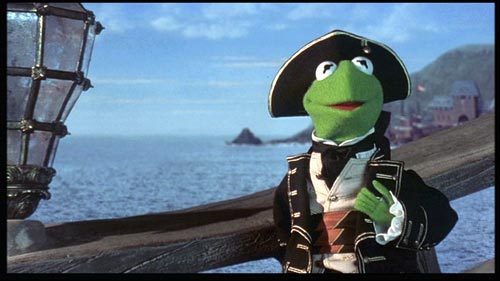
But Jim’s job as cabin boy means that he assists Silver in the galley, and just like in other versions of the tale, the two form a father/son relationship. Unlike other versions, Rizzo books a number of middle-aged rat couples on a “Caribbean cruise” aboard the ship, and Gonzo finds out what the pirates are up to, and is tortured (which Gonzo, being Gonzo, finds both cool and enjoyable) Dr. Honeydew and Bunsen show up to un-do the results of the torture.
In order to provide a fun musical number, the ship is caught without wind, and the crew suffers from “cabin fever.” This results in more chaos, Carmen Miranda costumes, square dancing, singing in German, Mariachi hats and an appearance by Lew Zealand and his boomerang fish.

Once they reach the island, Silver kidnaps Jim in order to obtain the compass left to the boy by his seafaring father. Kermit, Fozzie, Gonzo and Rizzo go to the rescue and end up captured by savage pigs.
And here we have a problem. The real story of T.I. contains no women. How can the Muppets add Piggy to the mix? Answer: Make Piggy the leader of the local natives, and also give her the part of Ben Gunn (now Benjamina Gunn), maroonee. The Swedish Chef shows up at the feast, dressed like a pig.

Here we learn that Benjamina and Smollett were engaged to be married, and Smollett left Benjamina at the altar. (Frogs always get cold feet.) After a confrontation, Benjamina agrees to help her former lover.
Meanwhile, the pirates have a musical number (played by The Electric Mayhem) and find the original location of the buried treasure, only to discover it has been removed. The causes a brief mutiny against Silver, who puts his life on the line to allow Jim to escape. The pirates then capture Benjamina and Smollett, and find out where Benjamina has hidden the gold. Then the pirates and hang them over a cliff. As the rope slowly frays, the two make up and have an upside down duet and fall back in love.
They are rescued when Jim brings the ship under them, and the figureheads (played by Statler and Waldorf) catch them. A fight with the pirates follows. Jim and his Muppet friends prove very brave, and Silver and his men are captured.

True to T.I. tradition, Long John Silver escapes before he can be brought to justice, getting away with a lifeboat full of treasure. But the boat sinks, and Silver loses it all. The movie ends with the rats scuba diving to the tune of reggae music, trying to raise the treasure.
The movie charming because it simply uses the Muppets to add warmth and color to an already colorful tale, while remaining in the spirit of the original and letting all the Muppets pretty much be themselves.
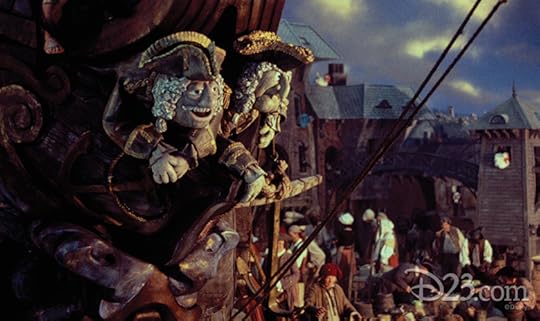
One more interesting fact about the movie – because of it, Hormel (makers of Spam) sued Henson Productions, claiming that the wild pig character Spa’am had damaged their product name integrity. The judge threw it out, on the basis that 1. Hormel could not prove that any damage was done. 2. “Hormel should be pleased to have their product associated with a genuine source of pork.”

Whether it’s as a genuine source of pork or hamming it up, the Muppets add a lot of affection and humor to a sometimes frightening tale. It’s a wonderful way to introduce kids to a classic story, and an loving retelling that will warm the hearts of adults as well.

Muppet Treasure Islandwas released in 1996, the second movie after the tragic death of Muppet founder Jim Henson. It followed Muppet Christmas Carol, a movie which was successful, and it used some of the same storytelling techniques. Like the previous movie, it uses live humans as the main characters (in this case Kevin Bishop as Jim Hawkins, and Tim Curry as Long John Silver) and employed Gonzo and Rizzo the Rat as narrators.
The original intent had been for Gonzo and Rizzo to BE Jim Hawkins (one playing a character named Jim, the other playing a character named Hawkins.) But the writers quickly realized that the heart of Treasure Island is Jim’s development. Since Muppets, almost by definition, do not develop their characters, the lead in Treasure Island must be human. And if Jim was human, Silver, to maintain the proper relationship, must be human too.

Muppet movies as usually short, and MTI clocks in at 99 minutes (1 hour and 39 minutes.) For this reason, the story has been substantially modified. It has also been modified in order to stick to the “rules” of the Muppet universe.
Muppets need a G rating, and the material needs to be innocent and kid-friendly. This means that the drunken antics of the pirates can’t be shown, and also that certain sections of the book, including Jim’s killing of Israel Hands needed to be cut out. Another “rule” of Muppet movies is that ALL the important Muppets must make an appearance in every movie. (This will be important.)

The movie starts a chorus of Muppet wildlife singing “Shiver My Timbers” as Captain Flint and his human crew take the treasure to be buried. The song, the ferocious-looking Flint and the human pirates convey a sense of danger and dread, and the scene ends as Flint pulls his pistols and murders his crew members (off screen.)
Cut to the inside of an Inn, where it is revealed that this is a story being told by Billy Bones – played by Billy Connolly. We also meet Jim Hawkins, Gonzo and Rizzo, who are three friends who work at the Inn in exchange for a food and a place to sleep. Gonzo longs for adventure, Rizzo longs for food, and Jim longs to go to sea, following the footsteps of his deceased father.

This very night, Blind Pew and a host of former pirates - some human, some Muppet - show up, trying to steal Bones’ map. Bones dies of heart failure (played for laughs with several fake-out deaths) and various Muppet hijinks ensue. Jim and his friends end up on the road, alone, carrying the map.
By cutting out Jim’s mother and his ownership interest in the Inn, the story moves forward much faster, and several characters are eliminated, making for a more streamlines story.
Looking for a ship to take them to Treasure Island, Jim and company show up on the doorstep of Squire Trelawney, Fozzie Bear, who in this movie is the dimwitted son of a shipbuilder. To prove that Fozzie is playing a confused character (and it’s not just Fozzie’s own mental and emotional limitations) the character is given a sidekick, Mr. Bimbo, and invisible man who lives in Fozzie’s finger. Clearly, this character is just the sort of person who would loan a valuable ship to complete strangers on the strength of a treasure map.

This action speeds up the story once again, and eliminates some more of the pirate doings.

Along with the ship comes Long John Silver – Tim Curry, with a pet lobster on his shoulder instead of a parrot. The crew of the ship consists of various lesser-known Muppets, including Sam the Eagle and Sweetums. Kermit plays Captain Smollett, and immediately wins our support by telling Jim, “I knew your father. He was a good man.”

But Jim’s job as cabin boy means that he assists Silver in the galley, and just like in other versions of the tale, the two form a father/son relationship. Unlike other versions, Rizzo books a number of middle-aged rat couples on a “Caribbean cruise” aboard the ship, and Gonzo finds out what the pirates are up to, and is tortured (which Gonzo, being Gonzo, finds both cool and enjoyable) Dr. Honeydew and Bunsen show up to un-do the results of the torture.
In order to provide a fun musical number, the ship is caught without wind, and the crew suffers from “cabin fever.” This results in more chaos, Carmen Miranda costumes, square dancing, singing in German, Mariachi hats and an appearance by Lew Zealand and his boomerang fish.

Once they reach the island, Silver kidnaps Jim in order to obtain the compass left to the boy by his seafaring father. Kermit, Fozzie, Gonzo and Rizzo go to the rescue and end up captured by savage pigs.
And here we have a problem. The real story of T.I. contains no women. How can the Muppets add Piggy to the mix? Answer: Make Piggy the leader of the local natives, and also give her the part of Ben Gunn (now Benjamina Gunn), maroonee. The Swedish Chef shows up at the feast, dressed like a pig.

Here we learn that Benjamina and Smollett were engaged to be married, and Smollett left Benjamina at the altar. (Frogs always get cold feet.) After a confrontation, Benjamina agrees to help her former lover.
Meanwhile, the pirates have a musical number (played by The Electric Mayhem) and find the original location of the buried treasure, only to discover it has been removed. The causes a brief mutiny against Silver, who puts his life on the line to allow Jim to escape. The pirates then capture Benjamina and Smollett, and find out where Benjamina has hidden the gold. Then the pirates and hang them over a cliff. As the rope slowly frays, the two make up and have an upside down duet and fall back in love.
They are rescued when Jim brings the ship under them, and the figureheads (played by Statler and Waldorf) catch them. A fight with the pirates follows. Jim and his Muppet friends prove very brave, and Silver and his men are captured.

True to T.I. tradition, Long John Silver escapes before he can be brought to justice, getting away with a lifeboat full of treasure. But the boat sinks, and Silver loses it all. The movie ends with the rats scuba diving to the tune of reggae music, trying to raise the treasure.
The movie charming because it simply uses the Muppets to add warmth and color to an already colorful tale, while remaining in the spirit of the original and letting all the Muppets pretty much be themselves.

One more interesting fact about the movie – because of it, Hormel (makers of Spam) sued Henson Productions, claiming that the wild pig character Spa’am had damaged their product name integrity. The judge threw it out, on the basis that 1. Hormel could not prove that any damage was done. 2. “Hormel should be pleased to have their product associated with a genuine source of pork.”

Whether it’s as a genuine source of pork or hamming it up, the Muppets add a lot of affection and humor to a sometimes frightening tale. It’s a wonderful way to introduce kids to a classic story, and an loving retelling that will warm the hearts of adults as well.
Published on May 09, 2016 19:49
May 2, 2016
Jim Hawkins
Much is written about Treasure Island – it’s the most iconic pirate story of all time. And much has been written about Long John Silver, the pirate star. But there’s a lot more to this story than just one guy, so I’d like to put in a word for Jim Hawkins, the young man who narrates the story.
Robert Lewis Stevenson, the author, knew his pirates, and the fact that this boy is named Hawkins is likely no accident. Admiral John Hawkins was an Elizabethan naval hero and sometime pirate (but only, you know, when no one was looking.) So Jim Hawkins starts out with an illustrious name.
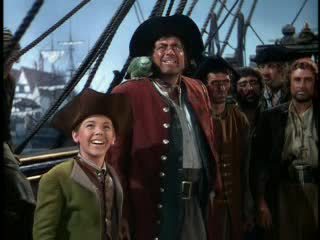 Bobby Driscoll 1950
Bobby Driscoll 1950
And the boy is bright. While Billy Bones, the pirate with the map, is slowly drinking himself to death at the Benbow Inn, home of Jim’s family, Jim is wise enough to notice that the pirate’s bloodcurdling tales of high-seas robbery and murder don’t just horrify the local farmers and tradesmen – they thrill and entertain.
So when Bones dies, and Jim and his mother discover the map, Jim is already set up to imagine a little adventure for himself. As a person not yet legally an adult, Jim needs the help and support of an adult – and in the book this is Doctor Livesey – the local physician.
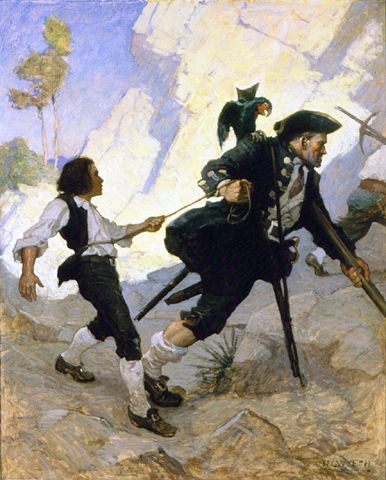 Drawn by N.C. Wyeth
Drawn by N.C. Wyeth
In many ways, Treasure Island is Jim’s coming of age story. The novel is also a turning point in Jim’s life. Livesey is all that a man should be – wise, kind, purposeful and practical. He stands in contrast to Long John Silver, who is… well, he’s a pirate, need we say anything more? While movies of the tale often play up the father/son relationship between Jim and Long John, the book makes it clear that one of Jim’s desires is to make Doctor Livesey proud of him.
It should be noted, also, that in the book, Jim has a father who dies only a few months before the real action of the novel kicks in. The boy has not suffered from the lack of a male role model.
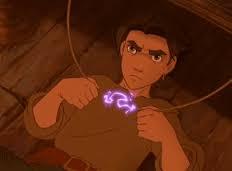 From Treasure Planet
From Treasure Planet
Movies usually show a different version of Jim’s home life. In most, his father is long dead, and his widowed mother stressed by running the Inn single-handedly. In Treasure Planet, Jim's father walked out on his family, leaving young Jim growing into a juvenile delinquent. In some (such as one of my favorites Muppet Treasure Island) Jim is an orphan, working at the aforementioned Inn for his room and board.
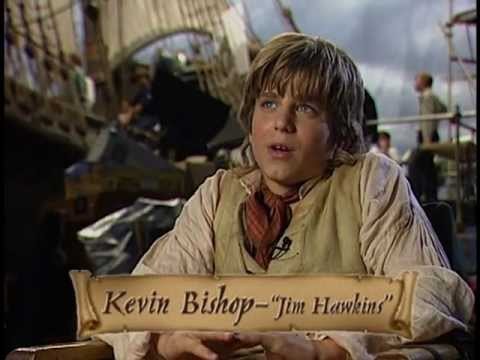 Muppet Treasure Island
Muppet Treasure Island
Jim’s age is never mentioned, and varies wildly in movies. Some version show him as young as seven, and in others he is a (more likely) fifteen or sixteen. It’s important to remember that one of Jim’s actions is the shooting (in self-defense) of a pirate bent on murdering him. Not an appropriate action for a seven-year old, and a serious business for a person of any age.
Stephenson, writing in the 1800’s, was trying to make a story of wild adventure where a boy could be the center of the action. He could not gloss over the realities that his characters lived in, however. Jim can’t hire the ship that takes him to Treasure Island, and he can’t sail it – he doesn’t know those skills. But he does learn.
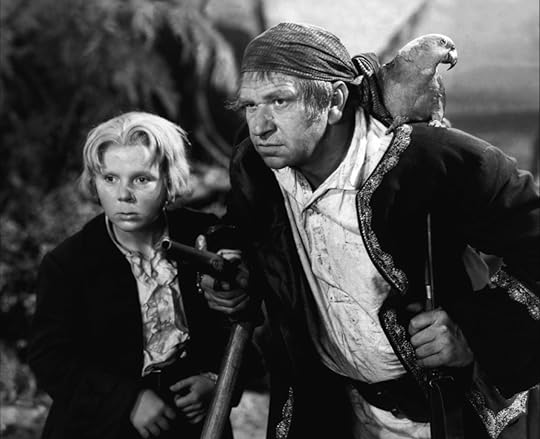 Jackie Cooper 1934
Jackie Cooper 1934
Confined to the actual abilities of an actual boy, Jim discovers Siler’s plans to mutiny while inside an apple barrel, trying to reach the last of the fruit. On the island, his nature drives him to go places where adults might not go, which in turn leads him to the marooned Ben Gunn. Gunn becomes a powerful ally, which he would not have done if Jim had not met him.
 Played by a Dog on Wishbone
Played by a Dog on Wishbone
In the book unlike the movie, Jim and Silver do not have a final farewell, and Silver gets away with a sizable sack of treasure at the first civilized poet on the way home. The adults are in town, “having rum punch” and probably looking up some of the local women – activities that Jim is still judged to immature to take part in.
In the end, Jim and his companions take the place of Billy Bones – they have adventures to tell that excite the neighbors, and will probably keep Jim drinking for free in taverns for the rest of his life. For in the book Treasure Island, there is more gold left to be had on the mysterious isle.
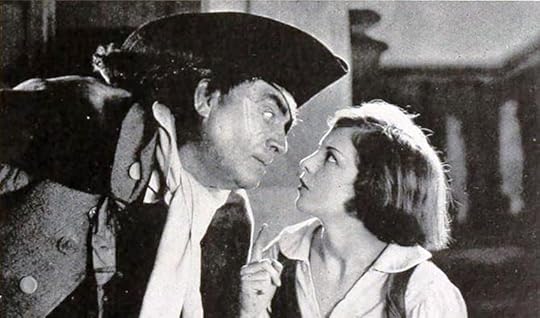 Shirley Manson 1920
Shirley Manson 1920
The Part of Jim Hawkins has been played by many famous actors. In 1920 the part was played by a woman, Shirley Manson. In 1934, Jackie Cooper took the part.
Probably the most famous Jim was Bobby Driscoll, in the 1950 Disney production. This is a very young Jim (Driscoll turned 12 during shooting), but Bobby had done other work for Disney. He would later be the voice and acting model for Peter Pan.
Christian Bale, (later Batman) took the part in 1989 at age 15 for a highly praised version of the story.
 Christian Bale 1989
Christian Bale 1989
Think that Jim Hawkins emerges from the story as a cross between his two heroes. Like Silver, he has proved himself to be an unconventional thinker, a dreamer, and able to kill when necessary But like Livesey, he cares about the expectations of society – he won’s be running off any time soon for life as a criminal.
On the other hand, I can’t believe that Jim sits home in his parent’s Inn and his tiny corner of England for the rest of his life. I think he’s bound to have some more adventures of his own. And since no one had written them yet, it may be something I have to do someday.
Robert Lewis Stevenson, the author, knew his pirates, and the fact that this boy is named Hawkins is likely no accident. Admiral John Hawkins was an Elizabethan naval hero and sometime pirate (but only, you know, when no one was looking.) So Jim Hawkins starts out with an illustrious name.
 Bobby Driscoll 1950
Bobby Driscoll 1950And the boy is bright. While Billy Bones, the pirate with the map, is slowly drinking himself to death at the Benbow Inn, home of Jim’s family, Jim is wise enough to notice that the pirate’s bloodcurdling tales of high-seas robbery and murder don’t just horrify the local farmers and tradesmen – they thrill and entertain.
So when Bones dies, and Jim and his mother discover the map, Jim is already set up to imagine a little adventure for himself. As a person not yet legally an adult, Jim needs the help and support of an adult – and in the book this is Doctor Livesey – the local physician.
 Drawn by N.C. Wyeth
Drawn by N.C. WyethIn many ways, Treasure Island is Jim’s coming of age story. The novel is also a turning point in Jim’s life. Livesey is all that a man should be – wise, kind, purposeful and practical. He stands in contrast to Long John Silver, who is… well, he’s a pirate, need we say anything more? While movies of the tale often play up the father/son relationship between Jim and Long John, the book makes it clear that one of Jim’s desires is to make Doctor Livesey proud of him.
It should be noted, also, that in the book, Jim has a father who dies only a few months before the real action of the novel kicks in. The boy has not suffered from the lack of a male role model.
 From Treasure Planet
From Treasure PlanetMovies usually show a different version of Jim’s home life. In most, his father is long dead, and his widowed mother stressed by running the Inn single-handedly. In Treasure Planet, Jim's father walked out on his family, leaving young Jim growing into a juvenile delinquent. In some (such as one of my favorites Muppet Treasure Island) Jim is an orphan, working at the aforementioned Inn for his room and board.
 Muppet Treasure Island
Muppet Treasure IslandJim’s age is never mentioned, and varies wildly in movies. Some version show him as young as seven, and in others he is a (more likely) fifteen or sixteen. It’s important to remember that one of Jim’s actions is the shooting (in self-defense) of a pirate bent on murdering him. Not an appropriate action for a seven-year old, and a serious business for a person of any age.
Stephenson, writing in the 1800’s, was trying to make a story of wild adventure where a boy could be the center of the action. He could not gloss over the realities that his characters lived in, however. Jim can’t hire the ship that takes him to Treasure Island, and he can’t sail it – he doesn’t know those skills. But he does learn.
 Jackie Cooper 1934
Jackie Cooper 1934Confined to the actual abilities of an actual boy, Jim discovers Siler’s plans to mutiny while inside an apple barrel, trying to reach the last of the fruit. On the island, his nature drives him to go places where adults might not go, which in turn leads him to the marooned Ben Gunn. Gunn becomes a powerful ally, which he would not have done if Jim had not met him.
 Played by a Dog on Wishbone
Played by a Dog on WishboneIn the book unlike the movie, Jim and Silver do not have a final farewell, and Silver gets away with a sizable sack of treasure at the first civilized poet on the way home. The adults are in town, “having rum punch” and probably looking up some of the local women – activities that Jim is still judged to immature to take part in.
In the end, Jim and his companions take the place of Billy Bones – they have adventures to tell that excite the neighbors, and will probably keep Jim drinking for free in taverns for the rest of his life. For in the book Treasure Island, there is more gold left to be had on the mysterious isle.
 Shirley Manson 1920
Shirley Manson 1920The Part of Jim Hawkins has been played by many famous actors. In 1920 the part was played by a woman, Shirley Manson. In 1934, Jackie Cooper took the part.
Probably the most famous Jim was Bobby Driscoll, in the 1950 Disney production. This is a very young Jim (Driscoll turned 12 during shooting), but Bobby had done other work for Disney. He would later be the voice and acting model for Peter Pan.
Christian Bale, (later Batman) took the part in 1989 at age 15 for a highly praised version of the story.
 Christian Bale 1989
Christian Bale 1989Think that Jim Hawkins emerges from the story as a cross between his two heroes. Like Silver, he has proved himself to be an unconventional thinker, a dreamer, and able to kill when necessary But like Livesey, he cares about the expectations of society – he won’s be running off any time soon for life as a criminal.
On the other hand, I can’t believe that Jim sits home in his parent’s Inn and his tiny corner of England for the rest of his life. I think he’s bound to have some more adventures of his own. And since no one had written them yet, it may be something I have to do someday.
Published on May 02, 2016 20:52
April 25, 2016
The Difference between Pirates and Privateers
When I give presentations, I am often asked the difference between pirates and privateers. In fact, pirates and privateers, though not legally alike at all, were very closely linked in actual practice.
First – the definition. Pirates – people who commit robberies at sea.Privateers – ships or ship’s companies with a license – called a letter of marque – issued by their government to attack enemy shipping during wartime.

Not much in common, right?
If you’ve been reading this blog, you know a lot about pirates, but let’s look a little more closely at the practice of privateering.
Why did privateering start? The need to license privately owned ships into Navy vessels may be caused by many things. Ships might be needed quickly – such as due to a sudden outbreak of war. It can take years to build a warship, so acquiring the services of existing vessels is a quick way to get warships.
Another pressure that drove the need for privateers was a lack of funds. If a country was under-funded, it would be cheaper to license privateers than to fund navy ships. Privateers paid for the right to carry a Letter of Marque, and they brought income into their nation’s treasure through captured goods.

At the time when privateering was common, it was lawful for nations to capture civilian merchant ships during war. Normally, a percentage of the value of the captured ship and cargo was divided among the officers and crew of the capturer, and the rest went to the nation. The owner of the captured ship was simply out of luck unless he had insurance.
Once a ship had been captured, it became a “prize.” The capturing ship put a small crew aboard the prize, which sailed it to one of many designated “prize ports” where the ship would be examined by specialists hired by the navy.
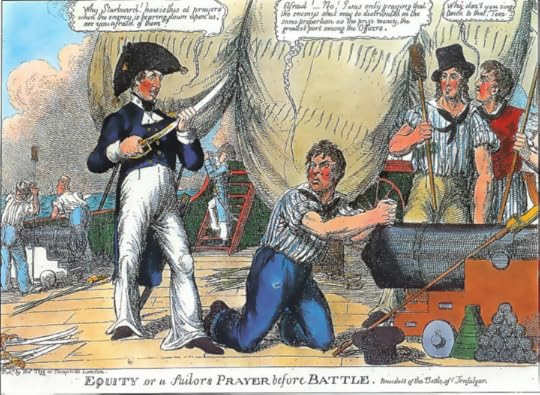 In this cartoon, the officer asks if the sailor is frightened. The sailor replies that he prays that the casualties will be distributed the same as the rewards (meaning that almost all will go to the officers.)
In this cartoon, the officer asks if the sailor is frightened. The sailor replies that he prays that the casualties will be distributed the same as the rewards (meaning that almost all will go to the officers.)
The value of the ship and cargo was determined, and the ship and goods would be auctioned off, or else purchased by the navy (if, for instance, the ship could be used as a war ship, or the cargo was some sort of material valuable to the military.) Funds made their way back to the capturing ship in a few months. Oftentimes, however, banks would issue loans to the sailors, holding their share of the captured ship as collateral.
Many, many ships began as war ships for one nation, and ended up serving another after being captured. And many, many navy captains made fortunes by capturing valuable goods from their enemies.
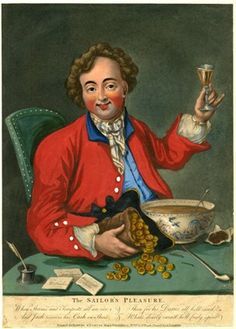
Privateering ships did much the same job. They were intended to disrupt enemy shipping. But if they succeeded in capturing prizes, the money was split between the ship’s owner and its captain and crew. The owner of a successful privateering ship might become immensely wealthy.
Of course, he might also lose his own vessel, sunk of captured, during the first battle. It was simply a gamble, one in which only the licensing nation was sure to win. Only the license and the fee were a sure thing.
So what has this got to do with pirates? For one thing, if a privateering ship did not have its paperwork in order, it could be condemned as a pirate, even by its own country. The ship was forfeit, its captain and crew jailed for piracy. The owner could counter-sue, and sometimes these cases were in court for years.
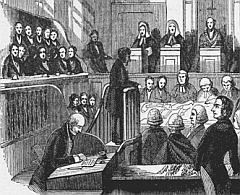
But this depended on getting caught, or even who caught you. There was the issue of probable cause. Navy ships were supposed to keep privateers in line. But why bother to inspect the paperwork of a ship fighting on the same side as yourself?
It was more likely to happen to someone who annoyed navy captains or the officials of a port. If paperwork was not correct, a privateer captain might lose everything. Or his transgression might be overlooked because of friendship between captain, a dislike of bureaucracy, or simple bribery. Like privateering itself, this was a gamble.
Captain Morgan - of rum fame - often raided Spanish towns when he did not have authority to do so. But the huge amounts of money he shared with government authorities kept him out of trouble. And during the American Revolution, Benjamin Franklin wrote and sold many Letters of Marque to patriots and opportunists. His motivation was to increase the power of his nation, but he did not have the right to issue these documents. Everyone carrying a Letter of Marque signed by Franklin was, technically, a pirate.
[image error]
Privateers also deliberately became pirates. The captain and crew of a privateering ship were not paid a salary. Instead they worked on a “No prey, no pay” policy. So if a privateering ship had not captured any enemy vessels for while it might start to “fudge” the rules, attacking ships that were neutral or even allies.
In this case, the privateer’s men were counting on not being caught. This happed more frequently when a ship was far from home – The Indian Ocean and the Caribbean were both prime territory for a ship to practice a little piracy, with the hopes than no one back home in Europe would find out.
After a privateer had made one illegal attack, it might give up on lawful practice and simply go turn to piracy. Or, once might be enough, and the ship would follow the straight-and-narrow ever afterwards.
Sometimes these wayward privateersmen were discovered years later, and lawsuits would be issued. At this time, the captain of the privateering ship would claim that he believed that he had a legal right do whatever he was in trouble for. The ship’s former owner would demand satisfaction. Court cases, once again, dragged on for years.
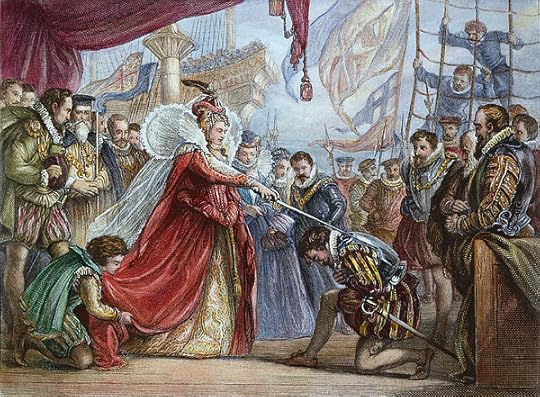
And, just as privateers became pirates, pirates sought to cover their activities be claiming to be lawful privateers. Some may have even thought of themselves as acting legally. Ben Hornigold refused to attack English ships for just this reason. Captain Morgan never considered himself a pirate. Men like Francis Drake and John Hawkins were considered heroes by their own nation, and pirates by the Spanish whom they robbed.
Lastly, pirates did not want to advertise that they were pirates while in port. While on land, they wanted to have a good time, not clash with the authorities. So the word “privateer” would be used, often with a wink, a nod, and a maybe gold coin to whoever was asking. And if the man in question was buying drinks, who cared?
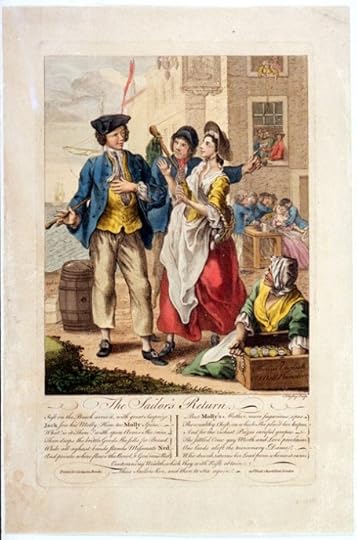 Every sailor's dream returning home safe to a loving family -
Every sailor's dream returning home safe to a loving family -
And with enough money to impress the mother-in-law!
First – the definition. Pirates – people who commit robberies at sea.Privateers – ships or ship’s companies with a license – called a letter of marque – issued by their government to attack enemy shipping during wartime.

Not much in common, right?
If you’ve been reading this blog, you know a lot about pirates, but let’s look a little more closely at the practice of privateering.
Why did privateering start? The need to license privately owned ships into Navy vessels may be caused by many things. Ships might be needed quickly – such as due to a sudden outbreak of war. It can take years to build a warship, so acquiring the services of existing vessels is a quick way to get warships.
Another pressure that drove the need for privateers was a lack of funds. If a country was under-funded, it would be cheaper to license privateers than to fund navy ships. Privateers paid for the right to carry a Letter of Marque, and they brought income into their nation’s treasure through captured goods.

At the time when privateering was common, it was lawful for nations to capture civilian merchant ships during war. Normally, a percentage of the value of the captured ship and cargo was divided among the officers and crew of the capturer, and the rest went to the nation. The owner of the captured ship was simply out of luck unless he had insurance.
Once a ship had been captured, it became a “prize.” The capturing ship put a small crew aboard the prize, which sailed it to one of many designated “prize ports” where the ship would be examined by specialists hired by the navy.
 In this cartoon, the officer asks if the sailor is frightened. The sailor replies that he prays that the casualties will be distributed the same as the rewards (meaning that almost all will go to the officers.)
In this cartoon, the officer asks if the sailor is frightened. The sailor replies that he prays that the casualties will be distributed the same as the rewards (meaning that almost all will go to the officers.)The value of the ship and cargo was determined, and the ship and goods would be auctioned off, or else purchased by the navy (if, for instance, the ship could be used as a war ship, or the cargo was some sort of material valuable to the military.) Funds made their way back to the capturing ship in a few months. Oftentimes, however, banks would issue loans to the sailors, holding their share of the captured ship as collateral.
Many, many ships began as war ships for one nation, and ended up serving another after being captured. And many, many navy captains made fortunes by capturing valuable goods from their enemies.

Privateering ships did much the same job. They were intended to disrupt enemy shipping. But if they succeeded in capturing prizes, the money was split between the ship’s owner and its captain and crew. The owner of a successful privateering ship might become immensely wealthy.
Of course, he might also lose his own vessel, sunk of captured, during the first battle. It was simply a gamble, one in which only the licensing nation was sure to win. Only the license and the fee were a sure thing.
So what has this got to do with pirates? For one thing, if a privateering ship did not have its paperwork in order, it could be condemned as a pirate, even by its own country. The ship was forfeit, its captain and crew jailed for piracy. The owner could counter-sue, and sometimes these cases were in court for years.

But this depended on getting caught, or even who caught you. There was the issue of probable cause. Navy ships were supposed to keep privateers in line. But why bother to inspect the paperwork of a ship fighting on the same side as yourself?
It was more likely to happen to someone who annoyed navy captains or the officials of a port. If paperwork was not correct, a privateer captain might lose everything. Or his transgression might be overlooked because of friendship between captain, a dislike of bureaucracy, or simple bribery. Like privateering itself, this was a gamble.
Captain Morgan - of rum fame - often raided Spanish towns when he did not have authority to do so. But the huge amounts of money he shared with government authorities kept him out of trouble. And during the American Revolution, Benjamin Franklin wrote and sold many Letters of Marque to patriots and opportunists. His motivation was to increase the power of his nation, but he did not have the right to issue these documents. Everyone carrying a Letter of Marque signed by Franklin was, technically, a pirate.
[image error]
Privateers also deliberately became pirates. The captain and crew of a privateering ship were not paid a salary. Instead they worked on a “No prey, no pay” policy. So if a privateering ship had not captured any enemy vessels for while it might start to “fudge” the rules, attacking ships that were neutral or even allies.
In this case, the privateer’s men were counting on not being caught. This happed more frequently when a ship was far from home – The Indian Ocean and the Caribbean were both prime territory for a ship to practice a little piracy, with the hopes than no one back home in Europe would find out.
After a privateer had made one illegal attack, it might give up on lawful practice and simply go turn to piracy. Or, once might be enough, and the ship would follow the straight-and-narrow ever afterwards.
Sometimes these wayward privateersmen were discovered years later, and lawsuits would be issued. At this time, the captain of the privateering ship would claim that he believed that he had a legal right do whatever he was in trouble for. The ship’s former owner would demand satisfaction. Court cases, once again, dragged on for years.

And, just as privateers became pirates, pirates sought to cover their activities be claiming to be lawful privateers. Some may have even thought of themselves as acting legally. Ben Hornigold refused to attack English ships for just this reason. Captain Morgan never considered himself a pirate. Men like Francis Drake and John Hawkins were considered heroes by their own nation, and pirates by the Spanish whom they robbed.
Lastly, pirates did not want to advertise that they were pirates while in port. While on land, they wanted to have a good time, not clash with the authorities. So the word “privateer” would be used, often with a wink, a nod, and a maybe gold coin to whoever was asking. And if the man in question was buying drinks, who cared?
 Every sailor's dream returning home safe to a loving family -
Every sailor's dream returning home safe to a loving family - And with enough money to impress the mother-in-law!
Published on April 25, 2016 14:12
April 18, 2016
Yo Ho Ho and a Bottle of Rum
An analysis of The Derelict - the most famous pirate poem of all time. The words “you ho ho and a bottle of rum” may be the most piratical, and the most famous, in all of literature. Many people. Including some folks who perform the song regularly, believe that it’s a real pirate song, sung by real pirates 300 years ago.
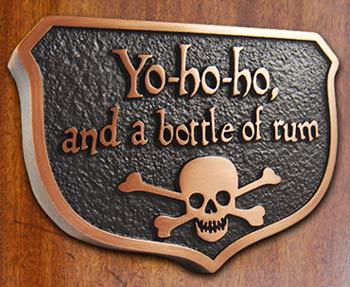
This isn’t quite true. But the song and its origins IS tied up with the legends of piracy.
The words “Fifteen men on the Dead Man’s Chest, Yo ho ho and a bottle of rum” appear first in Robert Lewis Stevenson’s 1883 novel, Treasure Island. In this famous tome, the words are the refrain of an old drinking song sung by members of Flint’s crew on his ship, the Walrus.
The words supply some early atmosphere, as the renegade pirate Billy Bones sings them to himself while he wanders the shore, keeping a wary lookout for this former shipmates, bound on revenge.
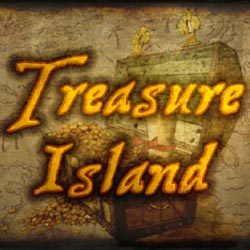
Later, it reveals the bond between Billy and his former shipmates. The words themselves are ominous, touching on death, treasure, the brotherhood of pirates (now breached by Billy) and the pirate’s favorite source of celebration and mayhem, rum.
Stevenson never wrote more than these few tantalizing tidbits. It fell to a newspaper man and sometime songwriter to Young Ewing Allison to complete the work. He wrote the entire lyric, and it was performed in the play Treasure Island, which debuted in 1901.
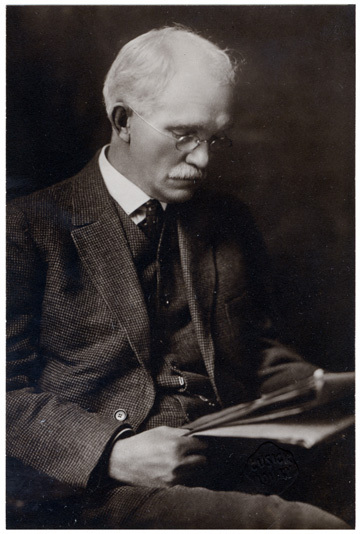 Young Ewing Allison
Young Ewing Allison
The Derelict
Fifteen men on the Dead Man's Chest— Drink and the devil had done for the rest— The mate was fixed by the bos'n's pike,The bos'n brained with a marlin spike,And Cookey's throat was marked belikeIt had been grippedBy fingers ten;And there they lay,All good dead menLike break-o'-day in a boozing-ken—Yo-ho-ho and a bottle of rum!
Fifteen men of the whole ship's list—Dead and be damned and the rest gone whist!—The skipper lay with his nob in goreWhere the scullion's axe his cheek had shore—And the scullion he was stabbed times four.And there they lay,And the soggy skiesDripped all day longIn upstaring eyes—In murk sunset and at foul sunrise—Yo-ho-ho and a bottle of rum!
Fifteen men of 'em stiff and stark—Ten of the crew had the Murder mark—'Twas a cutlass swipe or an ounce of lead,Or a yawing hole in a battered head—And the scuppers glut with a rotting redAnd there they lay—Aye, damn my eyes—All lookouts clappedOn paradise—All souls bound just contrariwise—Yo-ho-ho and a bottle of rum.
Fifteen men of 'em good and true—Every man jack could ha' sailed with Old Pew—There was chest on chest full of Spanish gold,With a ton of plate in the middle hold,And the cabins riot of stuff untold,And they lay there,That had took the plum,With sightless glareAnd their lips struck dumb,While we shared all by the rule of thumb—Yo-ho-ho and a bottle of rum!
More was seen through the stern light screen—Chartings no doubt where a woman had been!—A flimsy shift on a bunker cot,With a thin dirk slot through the bosom spotAnd the lace stiff dry in a purplish blot.Oh was she wench…Or some shuddering maid…?That dared the knife—And took the blade!By God! she was stuff for a plucky jade—Yo-ho-ho and a bottle of rum!
Fifteen men on the Dead Man's Chest—Drink and the devil had done for the rest—We wrapped 'em all in a mains'l tightWith twice ten turns of a hawser's bightAnd we heaved 'em over and out of sight—With a Yo-Heave-Ho!And a fare-you-well!And a sullen plungeIn the sullen swell,Ten fathoms deep on the road to hell!Yo-ho-ho and a bottle of rum!
The song describes a bloody scene on a derelict ship. In the first verse, we see that the first mate has been murdered by the bosun, using one of the bosun’s classic tool. In turn, the bosun has been killed by one of his own subordinates. We know this, once again, from the tool used for the murder. It is a marlin-spike, the tool of the sailors who work under supervision of the bosun, maintaining the ropes and sails. The ship’s cook has been strangled. Dead men lay all over, like partiers after a long night of drinking, a macabre comparison with these corpses.
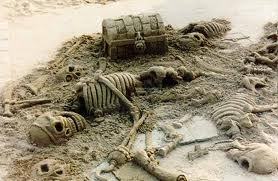
In the second verse, we note that anyone besides the corpses has fled the scene. “whist” being a turn-of-the-century contraction for “I know not where” The carnage has killed the captain – the most powerful man on the ship – and also the scullion, a position of unskilled kitchen help, probably the lowest person on board.
Once again, the observer describes the mayhem – death by strike of a cutlass (sword) or an ounce of lead (the bullet from a pistol of the time.) The scuppers – devices that drain water from the surface of the deck, are clogged with rotting blood. The dead lay with their eyes open, staring into a raining sky, as if looking toward heaven. But the observer know that anyone who has done these deeds will certainly go the other way.
 Blind Pew
Blind Pew
A quick remark to the pirate Pew, a character in Treasure Island. But what did the men fight over? Chests full of Spanish gold, and a ton of plate – from the Spanish word plata meaning sliver. When pirates refer to “plate” they mean bars of cast silver. The “stuff” referred to would be cloth – probably bolts of silk. The men who captured all this treasure (the plum) are dead, but the observer and his friends are happy to share it among themselves.
One more source of conflict can be found – a woman was in the stern cabin, usually the home of a ship’s captain. Her remains show her death, a stab wound through the breast of her nightgown. Was she a prostitute? Or a terrified virgin? The speaker does not know, but admits that she must have died with courage (pluck.)

The observer and his friends wrap the corpses in sailcloth, tie them with sturdy rope (the hawser) and give them the traditional burial at sea. The dead are going to hell, and the living may follow. But for now our observer and his friends have a huge amount of treasure, and probably plan on celebrating.
As an addition to the story of Treasure Island the song suggests how Flint and company may have found their enormous treasure. The story of murder, gold, and drink sets a perfect tone. But I’d like to add another note.

I believe that the scene described tells the story of a privateer’s crew, not a pirate vessel. Privateers divided their treasure unequally, with the captain and officers getting a much larger share. A privateer would also be much more likely to supply the captain with a pirate cabin (pirates did not allow the captain private use of the large stern cabin) A privateer captain was also more likely to keep a mistress on board.
This concept lends one more element of grim humor to the scene. If the original holders of the treasure were “honest” privateers, who broke out in rebellion over the uneven distribution of such a huge treasure, they had broken their own laws, died by murder and damned their souls to hell.
In the meantime, the pirates – honest thieves – divided the treasure evenly and sail away happy.

This isn’t quite true. But the song and its origins IS tied up with the legends of piracy.
The words “Fifteen men on the Dead Man’s Chest, Yo ho ho and a bottle of rum” appear first in Robert Lewis Stevenson’s 1883 novel, Treasure Island. In this famous tome, the words are the refrain of an old drinking song sung by members of Flint’s crew on his ship, the Walrus.
The words supply some early atmosphere, as the renegade pirate Billy Bones sings them to himself while he wanders the shore, keeping a wary lookout for this former shipmates, bound on revenge.

Later, it reveals the bond between Billy and his former shipmates. The words themselves are ominous, touching on death, treasure, the brotherhood of pirates (now breached by Billy) and the pirate’s favorite source of celebration and mayhem, rum.
Stevenson never wrote more than these few tantalizing tidbits. It fell to a newspaper man and sometime songwriter to Young Ewing Allison to complete the work. He wrote the entire lyric, and it was performed in the play Treasure Island, which debuted in 1901.
 Young Ewing Allison
Young Ewing AllisonThe Derelict
Fifteen men on the Dead Man's Chest— Drink and the devil had done for the rest— The mate was fixed by the bos'n's pike,The bos'n brained with a marlin spike,And Cookey's throat was marked belikeIt had been grippedBy fingers ten;And there they lay,All good dead menLike break-o'-day in a boozing-ken—Yo-ho-ho and a bottle of rum!
Fifteen men of the whole ship's list—Dead and be damned and the rest gone whist!—The skipper lay with his nob in goreWhere the scullion's axe his cheek had shore—And the scullion he was stabbed times four.And there they lay,And the soggy skiesDripped all day longIn upstaring eyes—In murk sunset and at foul sunrise—Yo-ho-ho and a bottle of rum!
Fifteen men of 'em stiff and stark—Ten of the crew had the Murder mark—'Twas a cutlass swipe or an ounce of lead,Or a yawing hole in a battered head—And the scuppers glut with a rotting redAnd there they lay—Aye, damn my eyes—All lookouts clappedOn paradise—All souls bound just contrariwise—Yo-ho-ho and a bottle of rum.
Fifteen men of 'em good and true—Every man jack could ha' sailed with Old Pew—There was chest on chest full of Spanish gold,With a ton of plate in the middle hold,And the cabins riot of stuff untold,And they lay there,That had took the plum,With sightless glareAnd their lips struck dumb,While we shared all by the rule of thumb—Yo-ho-ho and a bottle of rum!
More was seen through the stern light screen—Chartings no doubt where a woman had been!—A flimsy shift on a bunker cot,With a thin dirk slot through the bosom spotAnd the lace stiff dry in a purplish blot.Oh was she wench…Or some shuddering maid…?That dared the knife—And took the blade!By God! she was stuff for a plucky jade—Yo-ho-ho and a bottle of rum!
Fifteen men on the Dead Man's Chest—Drink and the devil had done for the rest—We wrapped 'em all in a mains'l tightWith twice ten turns of a hawser's bightAnd we heaved 'em over and out of sight—With a Yo-Heave-Ho!And a fare-you-well!And a sullen plungeIn the sullen swell,Ten fathoms deep on the road to hell!Yo-ho-ho and a bottle of rum!
The song describes a bloody scene on a derelict ship. In the first verse, we see that the first mate has been murdered by the bosun, using one of the bosun’s classic tool. In turn, the bosun has been killed by one of his own subordinates. We know this, once again, from the tool used for the murder. It is a marlin-spike, the tool of the sailors who work under supervision of the bosun, maintaining the ropes and sails. The ship’s cook has been strangled. Dead men lay all over, like partiers after a long night of drinking, a macabre comparison with these corpses.

In the second verse, we note that anyone besides the corpses has fled the scene. “whist” being a turn-of-the-century contraction for “I know not where” The carnage has killed the captain – the most powerful man on the ship – and also the scullion, a position of unskilled kitchen help, probably the lowest person on board.
Once again, the observer describes the mayhem – death by strike of a cutlass (sword) or an ounce of lead (the bullet from a pistol of the time.) The scuppers – devices that drain water from the surface of the deck, are clogged with rotting blood. The dead lay with their eyes open, staring into a raining sky, as if looking toward heaven. But the observer know that anyone who has done these deeds will certainly go the other way.
 Blind Pew
Blind PewA quick remark to the pirate Pew, a character in Treasure Island. But what did the men fight over? Chests full of Spanish gold, and a ton of plate – from the Spanish word plata meaning sliver. When pirates refer to “plate” they mean bars of cast silver. The “stuff” referred to would be cloth – probably bolts of silk. The men who captured all this treasure (the plum) are dead, but the observer and his friends are happy to share it among themselves.
One more source of conflict can be found – a woman was in the stern cabin, usually the home of a ship’s captain. Her remains show her death, a stab wound through the breast of her nightgown. Was she a prostitute? Or a terrified virgin? The speaker does not know, but admits that she must have died with courage (pluck.)

The observer and his friends wrap the corpses in sailcloth, tie them with sturdy rope (the hawser) and give them the traditional burial at sea. The dead are going to hell, and the living may follow. But for now our observer and his friends have a huge amount of treasure, and probably plan on celebrating.
As an addition to the story of Treasure Island the song suggests how Flint and company may have found their enormous treasure. The story of murder, gold, and drink sets a perfect tone. But I’d like to add another note.

I believe that the scene described tells the story of a privateer’s crew, not a pirate vessel. Privateers divided their treasure unequally, with the captain and officers getting a much larger share. A privateer would also be much more likely to supply the captain with a pirate cabin (pirates did not allow the captain private use of the large stern cabin) A privateer captain was also more likely to keep a mistress on board.
This concept lends one more element of grim humor to the scene. If the original holders of the treasure were “honest” privateers, who broke out in rebellion over the uneven distribution of such a huge treasure, they had broken their own laws, died by murder and damned their souls to hell.
In the meantime, the pirates – honest thieves – divided the treasure evenly and sail away happy.
Published on April 18, 2016 07:46
April 11, 2016
You Scurvy Dog!
Scurvy and pirates go together. Either as an insult or a disease, scurvy figured prominently in the lives of pirates and other sailors during the 18th century. Let’s take a look at this disease, and see what it meant to the pirate lifestyle.

As I learned all the way back in grade school, scurvy is a result of not having enough vitamin C in a person’s diet. At the time I learned that this caused teeth to loosen and fall out – something that didn’t seem all that horrible to a kid who was receiving regular visits from the Tooth Fairy. But scurvy is a much more insidious disease.
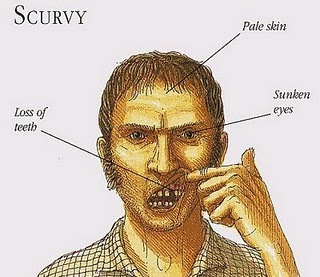
Like many diseases, scurvy was first described by then ancient Greek physician Hippocrates at about 300 BCE. The symptoms include depression, spots on the skin, especially the legs, exhaustion, sore gums, tooth loss, yellow skin, fever and eventually death. The full course of scurvy takes months, so the exact cause and effect were difficult to pin down.
Also, vitamin C is available from many sources. We think of it as coming from citrus fruit, including lemons, limes and oranges, but it is also abundant in green peppers, kale, spinach, and many other green vegetables. But such substances as whale skin, and liver can supply the necessary vitamins in places where no vegetable matter at all is available.

And to make the matter more confusing, Vitamin C is destroyed by cooking, or exposure to air, iron or copper. So a vitamin-rich substance, overcooked in an iron or copper pot and then left in the open air might lose nearly all of its life-giving properties.
We think of scurvy as being a sailor’s disease, and it most certainly was. Men on board ship, eating a diet that consisted mostly of preserved meat and bread, soon suffered from the results of scurvy. But the disease was also surprisingly common among city-dwellers, especially the poor.
During the late 1600’s and early 1700’s the populations of cities grew, but the means of preserving and transporting food did not improve. With no way to keep vegetables cold, or to quickly transport them, these foods often spoiled long before they could be transported to city markets. The poor lived primarily on meat and bread, a very limiting diet that deprived them of many necessary vitamins.
Surprisingly, the reason why city people did not often die of scurvy may have been beer – the heavy, black, bread-like beers common at the time carried some vitamin C. Also popular was a drink called bitters – essentially bitter herbs used to flavor beer. Alcohol does not destroy the vitamin. So bitters were a decent way to preserve the nutritional properties of plants.

The potato also saved countless lives. A single potato can contain up to 70% of the daily vitamin C needed by an average adult. Potatoes have always been cheap food, but during the Golden Age of Piracy, about 1715, they were not yet fully integrated into the European diet.
But neither beer nor potatoes hold up well on a damp, variable-temperature, constantly moving ship. The folklore of the sea said that greens were the answer to scurvy – though why this worked was not yet understood. Some of the best efforts to preserve the crew’s health involved cabbages – which hold up better than other greens.

Still, many, many sailors died or were permanently crippled by the disease. In its final stages, scurvy is truly horrible. Vitamin C is necessary for the human body to maintain connective tissue. Connective tissue might not seem particularly important, but it is literally what holds the human body together. In the latter stages of scurvy, old wounds re-open, once broken bones re-break, and the entire body begins to fall apart.
How horrible this must have been to people who did not understand that it was the result of the body not having crucial building materials at hand can only be imagined. Yet men continued to go to sea, in the hopes of riches and adventure.

It was not until 1753 when a Scottish surgeon in the Royal Navy, James Lind, first proved the disease could be treated with citrus fruit. He described his experiments in his 1753 book A Treatise of the Scurvy. Interestingly enough, Lind’s efforts to define and cure scurvy were the first “clinical trial” in medicine.
But his books was poorly written, and the medical establishment had already decided what it believed to be the cause of scurvy - notable hard work, bad water and the consumption of salt meat in a damp atmosphere. This certainly described life on board a ship, but it did not reveal the actual cause. Lind’s efforts to provide vitamin C to his subjects also were not successful – he boiled lemon juice to a concentrated state. Unfortunately the action of boiling also destroyed the vitamins.
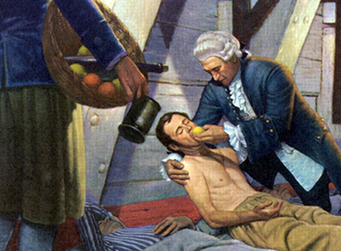
During Royal Navy expeditions, it was not uncommon for 2/3 of the crew to die from scurvy. Canny captains come up with their own remedies including British Vice Admiral Edward Vernon, known as “Old Grog” who added lime juice to his crew’s rum ration to control the disease.
The first long-range expedition free from scurvy was Captain Cook’s trip to the Pacific. Cook not only provided his men with preserved cabbage, in the form of sauerkraut, but as many fresh vegetables and fruit as he was able, but also insisted in scrupulous cleaning of the ship’s copper cooking pots, minimizing their vitamin-C leaching properties on other foods.

And the "scurvy dog" part? Well, diseases were a popular insult at the time. It wasn't uncommon to insult someone by saying that they were "poxy" meaning riddled with smallpox or marked by the disease. Such insults were used the way we might today refer to someone as an idiot.
And what has this to do with pirates? Well, as we have seen so often before, pirates operated from the bottom up – the opinions of the crew mattered as much or more than the leadership of the officers. For this reason, pirates often stopped on tropical islands to clean their ships, to party, and to consume native fruits and vegetables. Rum and fruit juice was an especial favorite. Pirates, you see, were much less likely to suffer from the disease.


As I learned all the way back in grade school, scurvy is a result of not having enough vitamin C in a person’s diet. At the time I learned that this caused teeth to loosen and fall out – something that didn’t seem all that horrible to a kid who was receiving regular visits from the Tooth Fairy. But scurvy is a much more insidious disease.

Like many diseases, scurvy was first described by then ancient Greek physician Hippocrates at about 300 BCE. The symptoms include depression, spots on the skin, especially the legs, exhaustion, sore gums, tooth loss, yellow skin, fever and eventually death. The full course of scurvy takes months, so the exact cause and effect were difficult to pin down.
Also, vitamin C is available from many sources. We think of it as coming from citrus fruit, including lemons, limes and oranges, but it is also abundant in green peppers, kale, spinach, and many other green vegetables. But such substances as whale skin, and liver can supply the necessary vitamins in places where no vegetable matter at all is available.

And to make the matter more confusing, Vitamin C is destroyed by cooking, or exposure to air, iron or copper. So a vitamin-rich substance, overcooked in an iron or copper pot and then left in the open air might lose nearly all of its life-giving properties.
We think of scurvy as being a sailor’s disease, and it most certainly was. Men on board ship, eating a diet that consisted mostly of preserved meat and bread, soon suffered from the results of scurvy. But the disease was also surprisingly common among city-dwellers, especially the poor.
During the late 1600’s and early 1700’s the populations of cities grew, but the means of preserving and transporting food did not improve. With no way to keep vegetables cold, or to quickly transport them, these foods often spoiled long before they could be transported to city markets. The poor lived primarily on meat and bread, a very limiting diet that deprived them of many necessary vitamins.
Surprisingly, the reason why city people did not often die of scurvy may have been beer – the heavy, black, bread-like beers common at the time carried some vitamin C. Also popular was a drink called bitters – essentially bitter herbs used to flavor beer. Alcohol does not destroy the vitamin. So bitters were a decent way to preserve the nutritional properties of plants.

The potato also saved countless lives. A single potato can contain up to 70% of the daily vitamin C needed by an average adult. Potatoes have always been cheap food, but during the Golden Age of Piracy, about 1715, they were not yet fully integrated into the European diet.
But neither beer nor potatoes hold up well on a damp, variable-temperature, constantly moving ship. The folklore of the sea said that greens were the answer to scurvy – though why this worked was not yet understood. Some of the best efforts to preserve the crew’s health involved cabbages – which hold up better than other greens.

Still, many, many sailors died or were permanently crippled by the disease. In its final stages, scurvy is truly horrible. Vitamin C is necessary for the human body to maintain connective tissue. Connective tissue might not seem particularly important, but it is literally what holds the human body together. In the latter stages of scurvy, old wounds re-open, once broken bones re-break, and the entire body begins to fall apart.
How horrible this must have been to people who did not understand that it was the result of the body not having crucial building materials at hand can only be imagined. Yet men continued to go to sea, in the hopes of riches and adventure.

It was not until 1753 when a Scottish surgeon in the Royal Navy, James Lind, first proved the disease could be treated with citrus fruit. He described his experiments in his 1753 book A Treatise of the Scurvy. Interestingly enough, Lind’s efforts to define and cure scurvy were the first “clinical trial” in medicine.
But his books was poorly written, and the medical establishment had already decided what it believed to be the cause of scurvy - notable hard work, bad water and the consumption of salt meat in a damp atmosphere. This certainly described life on board a ship, but it did not reveal the actual cause. Lind’s efforts to provide vitamin C to his subjects also were not successful – he boiled lemon juice to a concentrated state. Unfortunately the action of boiling also destroyed the vitamins.

During Royal Navy expeditions, it was not uncommon for 2/3 of the crew to die from scurvy. Canny captains come up with their own remedies including British Vice Admiral Edward Vernon, known as “Old Grog” who added lime juice to his crew’s rum ration to control the disease.
The first long-range expedition free from scurvy was Captain Cook’s trip to the Pacific. Cook not only provided his men with preserved cabbage, in the form of sauerkraut, but as many fresh vegetables and fruit as he was able, but also insisted in scrupulous cleaning of the ship’s copper cooking pots, minimizing their vitamin-C leaching properties on other foods.

And the "scurvy dog" part? Well, diseases were a popular insult at the time. It wasn't uncommon to insult someone by saying that they were "poxy" meaning riddled with smallpox or marked by the disease. Such insults were used the way we might today refer to someone as an idiot.
And what has this to do with pirates? Well, as we have seen so often before, pirates operated from the bottom up – the opinions of the crew mattered as much or more than the leadership of the officers. For this reason, pirates often stopped on tropical islands to clean their ships, to party, and to consume native fruits and vegetables. Rum and fruit juice was an especial favorite. Pirates, you see, were much less likely to suffer from the disease.

Published on April 11, 2016 20:12
April 4, 2016
To Hell or Barbados
No one knows which European nation first claimed the island of Barbados, though the name of the island is probably either Portuguese (Barbados) or Spanish (los Barbados) both meaning “bearded.” This may refer to the hanging, bearlike roots of the native fig-trees, or to way the sea-foam sprays out over the island’s surrounding reefs. Stories of bearded natives are also told, but there is no evidence of any such people.

The original inhabitants, members of the Arawak tribe, called it Ichirouganaim, meaning “red land with white teeth.” The island, the easternmost in the string of Caribbean islands called the Lesser Antilles, is one of the earliest to be colonized by Europeans, and most of the indigenous people left the island early on. By 1519, it was named and show in its correct position on European maps.
Another name for this island is Bim or Bimshire. This name is probably derived from the Igbo term meaning “The place where my people (kin) are.” This would be because of the relatively large number of enslaved Igbo people (from what is now south-eastern Nigeria) who were brought to the island.
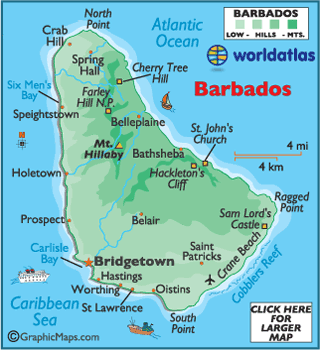
The island of Barbados is so far east it is actually a part of the Atlantic, but is described as a Caribbean island, mostly because of its place at the end of the Lesser Antilles chain, and also because of it cultural identity as Caribbean. First the Amerindians, and later European colonists treated it as Caribbean.
The English took control of Barbados in 1627. Unlike the Spanish, who were only interested in gold and silver at the time, the English were looking for places to grow tropical crops. Tobacco, cotton, indigo and ginger were all raised on the island.

But the island’s history includes a darker note. In its early years, hundreds of thousands of European poor, criminals (sometimes guilty of extremely minor offenses), Prisoners of War and religious minorities were sold into slavery on the island.
During the English Civil War, Ireland, which had been conquered by England, rebelled, trying to regain its freedom. The rebellion of 1641 was put down. When Oliver Cromwell, general of the Civil War’s winning side, took control of Ireland, he decided on an effort to eradicate the Irish people entirely. To this end, he encouraged transportation of the Irish to slave-labor camps in Barbados.
Estimates of the number of Irish transported range from 50,000 to over 500,000, but records are scarce, since during this time the Irish also faced famine, bubonic plague and cholera. An estimated 1/3 of the population either died or was transported.
Today Barbados is one of the most popular vacation destinations in the world, and it may be difficult to understand why transportation there from Ireland was such a harsh blow. Certainly it would be an emotionally stress to be cut off from one’s homeland, family, religion and language. But the difference in climate between the two islands is remarkable.
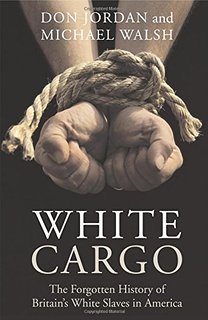
In Ireland today, the temperature rarely goes above 70 degrees Fahrenheit, and frequently sits at 85 degrees. Ireland in the 1600’s was just emerging from a “little ice age.” In contrast, the temperature in Barbados rarely dips below 70 degrees. Imagine the hottest temperature you’ve ever experienced, and now imagine that this is the coolest you’ll ever be again. Not a pleasant idea.
Many Europeans died in the harsh climate of the Caribbean, Eventually, slaves from Africa began to be imported. These people were better able to deal with the tropical climate, and as farming moved toward sugar production, African slaves became a near-necessity. Sugar production also brought about a business in the production of rum.
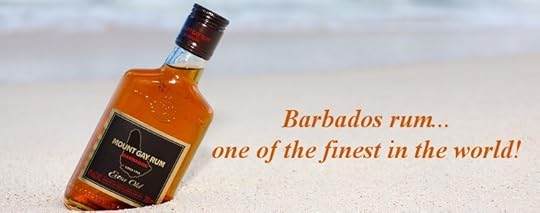
Barbados rum is still a valuable commodity, but during the Golden Age of Piracy, it was of such consistent high quality and value that it became a standard form of commerce, used alongside gold and silver as currency.
Barbados, like many other islands, faced several slave revolts, the largest of which was named “Bussa’s Rebellion” In 1816 a free African named Bussa, who had been kidnapped and sold to the English in Barbados, gathered a group of some 400 freedom fighters, both men and women. They attacked a plantation, and Bussa was killed in the action. His followers fought on until they were overwhelmed by the guns of the colonial militia.

While the rebellion was not successful it was part of a series of rebellions and uprisings which caused the British to reconsider the practice of slavery. When slavery was abolished in 1833, 83,000 people were released. Today the population of the island is over 90% of African descent, though a strong vein of Irish can also be seen in the faces of the people, and heard in its accent. A statue of Bussa stands in the island’s capital of Bridgetown.
Today Barbados has a thriving economy, a population that is nearly 100% literate, and a healthy concern for the protection of its natural beauty. In addition to its other attractions, it is considered to be the only Caribbean island not in the hurricane strike zone. While Irish rebels used to say that they were going to either “Hell or Barbados” when they headed out to battle for their own country’s freedom, Barbados is today a pleasant place to vacation.

The original inhabitants, members of the Arawak tribe, called it Ichirouganaim, meaning “red land with white teeth.” The island, the easternmost in the string of Caribbean islands called the Lesser Antilles, is one of the earliest to be colonized by Europeans, and most of the indigenous people left the island early on. By 1519, it was named and show in its correct position on European maps.
Another name for this island is Bim or Bimshire. This name is probably derived from the Igbo term meaning “The place where my people (kin) are.” This would be because of the relatively large number of enslaved Igbo people (from what is now south-eastern Nigeria) who were brought to the island.

The island of Barbados is so far east it is actually a part of the Atlantic, but is described as a Caribbean island, mostly because of its place at the end of the Lesser Antilles chain, and also because of it cultural identity as Caribbean. First the Amerindians, and later European colonists treated it as Caribbean.
The English took control of Barbados in 1627. Unlike the Spanish, who were only interested in gold and silver at the time, the English were looking for places to grow tropical crops. Tobacco, cotton, indigo and ginger were all raised on the island.

But the island’s history includes a darker note. In its early years, hundreds of thousands of European poor, criminals (sometimes guilty of extremely minor offenses), Prisoners of War and religious minorities were sold into slavery on the island.
During the English Civil War, Ireland, which had been conquered by England, rebelled, trying to regain its freedom. The rebellion of 1641 was put down. When Oliver Cromwell, general of the Civil War’s winning side, took control of Ireland, he decided on an effort to eradicate the Irish people entirely. To this end, he encouraged transportation of the Irish to slave-labor camps in Barbados.
Estimates of the number of Irish transported range from 50,000 to over 500,000, but records are scarce, since during this time the Irish also faced famine, bubonic plague and cholera. An estimated 1/3 of the population either died or was transported.
Today Barbados is one of the most popular vacation destinations in the world, and it may be difficult to understand why transportation there from Ireland was such a harsh blow. Certainly it would be an emotionally stress to be cut off from one’s homeland, family, religion and language. But the difference in climate between the two islands is remarkable.

In Ireland today, the temperature rarely goes above 70 degrees Fahrenheit, and frequently sits at 85 degrees. Ireland in the 1600’s was just emerging from a “little ice age.” In contrast, the temperature in Barbados rarely dips below 70 degrees. Imagine the hottest temperature you’ve ever experienced, and now imagine that this is the coolest you’ll ever be again. Not a pleasant idea.
Many Europeans died in the harsh climate of the Caribbean, Eventually, slaves from Africa began to be imported. These people were better able to deal with the tropical climate, and as farming moved toward sugar production, African slaves became a near-necessity. Sugar production also brought about a business in the production of rum.

Barbados rum is still a valuable commodity, but during the Golden Age of Piracy, it was of such consistent high quality and value that it became a standard form of commerce, used alongside gold and silver as currency.
Barbados, like many other islands, faced several slave revolts, the largest of which was named “Bussa’s Rebellion” In 1816 a free African named Bussa, who had been kidnapped and sold to the English in Barbados, gathered a group of some 400 freedom fighters, both men and women. They attacked a plantation, and Bussa was killed in the action. His followers fought on until they were overwhelmed by the guns of the colonial militia.

While the rebellion was not successful it was part of a series of rebellions and uprisings which caused the British to reconsider the practice of slavery. When slavery was abolished in 1833, 83,000 people were released. Today the population of the island is over 90% of African descent, though a strong vein of Irish can also be seen in the faces of the people, and heard in its accent. A statue of Bussa stands in the island’s capital of Bridgetown.
Today Barbados has a thriving economy, a population that is nearly 100% literate, and a healthy concern for the protection of its natural beauty. In addition to its other attractions, it is considered to be the only Caribbean island not in the hurricane strike zone. While Irish rebels used to say that they were going to either “Hell or Barbados” when they headed out to battle for their own country’s freedom, Barbados is today a pleasant place to vacation.
Published on April 04, 2016 13:43
March 28, 2016
The Indiana Pirate Fest
This past Saturday, I attended a land-locked pirate festival in the tiny, tiny town of Mishawaka Indiana. The Indiana Pirate Festival is in its third year. It was my third different all-pirate venue, and comes highly recommended.

First things first – the bad. Mishawaka is not a big place, and its proximity to the much larger City of South Bend makes it hard to find. In addition, the state of Indiana does not have the best road signage in the world. Be prepared to keep a sharp eye out when driving here.
I managed to get lost, and arrived late. Information about the fest had not listed a street address, only that it was taking place at the “BK Club.” Coming into town, I was nervous about overlooking a well-known but poorly-labeled venue. My fears were entirely unfounded. The crew had thoughtfully placed a huge pirate ship in the parking lot, and surrounded it with pirates to greet new arrivals and direct us to unloading and parking areas.
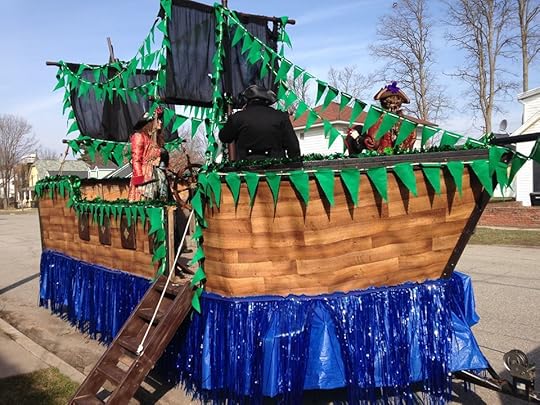
Many willing hands helped me into the building, and I quickly set up my vending table and changed into my pirate costume. (After one terrible afternoon lost is southern Wisconsin, I’ll never drive in garb again.) The fest had thoughtfully provided a changing room.
The space was one large room, clean, very well lighted, pretty, and well-kept. A small stage - as I was walking in the two men doing a fencing demonstration stopped after knocking something off the wall and informed the crowd “This is a VERY SMALL STAGE” – stood at one end of the space. Vendors took up much of the remaining area. The entrance was at the opposite end.
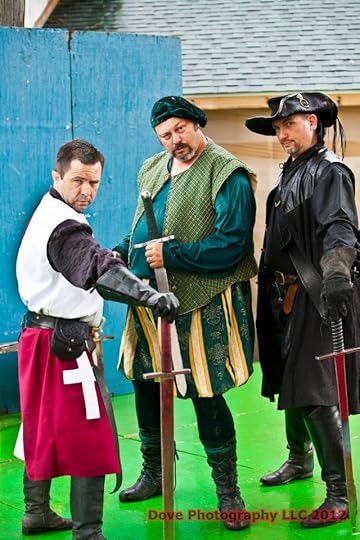
I immediately noticed that almost all the guests were wearing some effort at a pirate costume, and most of them were home-made, rather than something purchased over the internet. This gives a fest a real bonus. When the visitors get into the spirit and make an effort, everyone has a better time.
The two swordsmen – The Rogue Blades - managed to get through their act without killing each other or doing any more damage, and received a hearty round of applause. Rows of folding chairs provided seating for about 30 people. Most remained in place as the next act, Drunk and Sailor, began to sing sea shanties.
 I chatted with the folks in the booth next to me. They were member of the Great Lakes Pirates, taking portraits and offering pirate maps to promote their online magazine. We chatted about pirates, and I also engaged passersby in an effort to sell my wares – Books 1-3 of The Pirate Empire, and my non-fiction book, Pirate of the Golden Age.
I chatted with the folks in the booth next to me. They were member of the Great Lakes Pirates, taking portraits and offering pirate maps to promote their online magazine. We chatted about pirates, and I also engaged passersby in an effort to sell my wares – Books 1-3 of The Pirate Empire, and my non-fiction book, Pirate of the Golden Age.
Almost at once, a gentleman bought one of each for his girlfriend, young woman in a pirate/renaissance costume. She wanted each book autographed, and it was fun to oblige. While I was doing that, another individual wanted to buy some of my table decorations. No way!
Other vendors included two weapons dealers, someone selling wooden swords and pistols for the small fry, a handmade soap dealer, a pirate-themed pachinko game, a corset-maker, fantasy themed knickknacks, a Tandy leather store, one jewelry maker, and a booth called Steampunk Sweethearts, selling old-time jewelry, beautiful old books, and other fine things.
All in all, a good mix of vendors. All the products seemed well-made and nicely displayed. Pirates were going crazy in the weapons dealers, (just like we always do) but there was plenty of non-pirate items for the general public.
People moved through at a regular pace, smiling, talking and seeming to enjoy themselves. I saw not only pirates, but a wide variety of fairy princess, and four dragons (one of whom, a very patient Akita dog, won Ooohs and Aaahs of approval from the guests.)
 Drunk and Sailor The place was almost over-popular, but though my booth kept me in one area, I believe that other activities were happening in the parking lot. Certainly plenty of folks were having their pictures taken by the pirate ship.
Drunk and Sailor The place was almost over-popular, but though my booth kept me in one area, I believe that other activities were happening in the parking lot. Certainly plenty of folks were having their pictures taken by the pirate ship.
The next event on stage was a demonstration of black-powder guns, tough to do in a place where the weapons could not be fired, but it was exciting for me to see the genuine old guns, and unloaded muskets were passed around to the crowd.
My own act was up next. I presented “What’s in the Pirate’s Chest?” a look at some of the real items that a real pirate might have been carrying in 1715. My audience was small – I admit that what I was doing was less exciting than the singing, but the kids were attentive and afterwards several adults told me how much they had enjoyed it. I also sold more books.
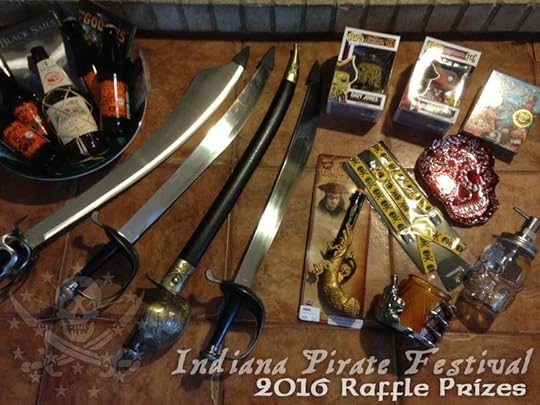 A beautifully-dressed group promoted a local renaissance fest. The pirates raffled off many lovely items, and the crow looked happy all day. I took some time to speak to one of the organizers, who told me that the first event had taken place in early December, and that few folk had attended. They didn’t seem to be having that problem this time.
A beautifully-dressed group promoted a local renaissance fest. The pirates raffled off many lovely items, and the crow looked happy all day. I took some time to speak to one of the organizers, who told me that the first event had taken place in early December, and that few folk had attended. They didn’t seem to be having that problem this time.
A group called Red Rum offered some beautiful ballads, and then the groups cycled through again. The site had a kitchen serving hot sandwiches, and a basement venue selling beer. Beer can be problematic at a pirate fest – in St Augustine, over 50 people had to be thrown out because of behavior unbecoming a pirate. Here, everyone was fine. As the day wore on, more voices were raised to sing along with the bands, but that was all.
I had a wonderful time, my books and my presentation were praised, and I sang until I was hoarse. A couple of pirates danced and Irish jig. The event ended at 6pm, though a pirate party was scheduled for later that night. I only wish I could have attended. But the long drive home was calling me. I offered a hearty good night to my new friends and drove off into the sunset.
I’ll be back next year. You should plan on it, too.

First things first – the bad. Mishawaka is not a big place, and its proximity to the much larger City of South Bend makes it hard to find. In addition, the state of Indiana does not have the best road signage in the world. Be prepared to keep a sharp eye out when driving here.
I managed to get lost, and arrived late. Information about the fest had not listed a street address, only that it was taking place at the “BK Club.” Coming into town, I was nervous about overlooking a well-known but poorly-labeled venue. My fears were entirely unfounded. The crew had thoughtfully placed a huge pirate ship in the parking lot, and surrounded it with pirates to greet new arrivals and direct us to unloading and parking areas.

Many willing hands helped me into the building, and I quickly set up my vending table and changed into my pirate costume. (After one terrible afternoon lost is southern Wisconsin, I’ll never drive in garb again.) The fest had thoughtfully provided a changing room.
The space was one large room, clean, very well lighted, pretty, and well-kept. A small stage - as I was walking in the two men doing a fencing demonstration stopped after knocking something off the wall and informed the crowd “This is a VERY SMALL STAGE” – stood at one end of the space. Vendors took up much of the remaining area. The entrance was at the opposite end.

I immediately noticed that almost all the guests were wearing some effort at a pirate costume, and most of them were home-made, rather than something purchased over the internet. This gives a fest a real bonus. When the visitors get into the spirit and make an effort, everyone has a better time.
The two swordsmen – The Rogue Blades - managed to get through their act without killing each other or doing any more damage, and received a hearty round of applause. Rows of folding chairs provided seating for about 30 people. Most remained in place as the next act, Drunk and Sailor, began to sing sea shanties.
 I chatted with the folks in the booth next to me. They were member of the Great Lakes Pirates, taking portraits and offering pirate maps to promote their online magazine. We chatted about pirates, and I also engaged passersby in an effort to sell my wares – Books 1-3 of The Pirate Empire, and my non-fiction book, Pirate of the Golden Age.
I chatted with the folks in the booth next to me. They were member of the Great Lakes Pirates, taking portraits and offering pirate maps to promote their online magazine. We chatted about pirates, and I also engaged passersby in an effort to sell my wares – Books 1-3 of The Pirate Empire, and my non-fiction book, Pirate of the Golden Age.Almost at once, a gentleman bought one of each for his girlfriend, young woman in a pirate/renaissance costume. She wanted each book autographed, and it was fun to oblige. While I was doing that, another individual wanted to buy some of my table decorations. No way!
Other vendors included two weapons dealers, someone selling wooden swords and pistols for the small fry, a handmade soap dealer, a pirate-themed pachinko game, a corset-maker, fantasy themed knickknacks, a Tandy leather store, one jewelry maker, and a booth called Steampunk Sweethearts, selling old-time jewelry, beautiful old books, and other fine things.
All in all, a good mix of vendors. All the products seemed well-made and nicely displayed. Pirates were going crazy in the weapons dealers, (just like we always do) but there was plenty of non-pirate items for the general public.
People moved through at a regular pace, smiling, talking and seeming to enjoy themselves. I saw not only pirates, but a wide variety of fairy princess, and four dragons (one of whom, a very patient Akita dog, won Ooohs and Aaahs of approval from the guests.)
 Drunk and Sailor The place was almost over-popular, but though my booth kept me in one area, I believe that other activities were happening in the parking lot. Certainly plenty of folks were having their pictures taken by the pirate ship.
Drunk and Sailor The place was almost over-popular, but though my booth kept me in one area, I believe that other activities were happening in the parking lot. Certainly plenty of folks were having their pictures taken by the pirate ship.The next event on stage was a demonstration of black-powder guns, tough to do in a place where the weapons could not be fired, but it was exciting for me to see the genuine old guns, and unloaded muskets were passed around to the crowd.
My own act was up next. I presented “What’s in the Pirate’s Chest?” a look at some of the real items that a real pirate might have been carrying in 1715. My audience was small – I admit that what I was doing was less exciting than the singing, but the kids were attentive and afterwards several adults told me how much they had enjoyed it. I also sold more books.
 A beautifully-dressed group promoted a local renaissance fest. The pirates raffled off many lovely items, and the crow looked happy all day. I took some time to speak to one of the organizers, who told me that the first event had taken place in early December, and that few folk had attended. They didn’t seem to be having that problem this time.
A beautifully-dressed group promoted a local renaissance fest. The pirates raffled off many lovely items, and the crow looked happy all day. I took some time to speak to one of the organizers, who told me that the first event had taken place in early December, and that few folk had attended. They didn’t seem to be having that problem this time. A group called Red Rum offered some beautiful ballads, and then the groups cycled through again. The site had a kitchen serving hot sandwiches, and a basement venue selling beer. Beer can be problematic at a pirate fest – in St Augustine, over 50 people had to be thrown out because of behavior unbecoming a pirate. Here, everyone was fine. As the day wore on, more voices were raised to sing along with the bands, but that was all.
I had a wonderful time, my books and my presentation were praised, and I sang until I was hoarse. A couple of pirates danced and Irish jig. The event ended at 6pm, though a pirate party was scheduled for later that night. I only wish I could have attended. But the long drive home was calling me. I offered a hearty good night to my new friends and drove off into the sunset.
I’ll be back next year. You should plan on it, too.
Published on March 28, 2016 19:16
March 21, 2016
Anne of the Indies – Pirate Spitfire
I’ve always said that I fell in love with pirates when I saw Johnny Depp stagger across the screen for the first time. It’s true – I felt, and still feel, that POTC got the pirate genre just right. The bad guys were really bad, but the good guys were a little bad, too. And everyone needed a bath.
But I recently had a major revelation about why pirates have been so dear to me. It came in the form of a movie, Anne of the Indies, which showed up on Turner Classic Movies a week ago.
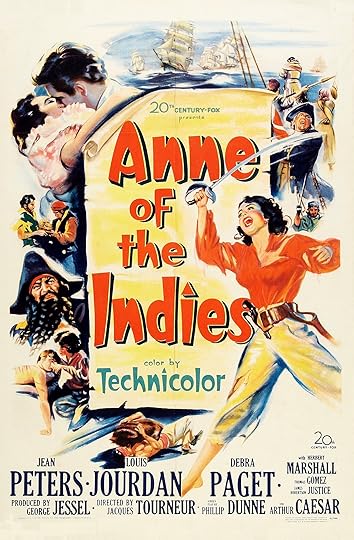
Suddenly it all came back. This 1951 adventure flick is so old that is was showing on TV when I was a child – a very small child I might add. And Anne of the Indies is about a female pirate.
Now, female pirates are still a very rare commodity, and they are rarely done right. Even the Queen of the Swashbucklers, Maureen O’Hara, didn’t captain her own ship, but held the honorary position of “Captain” because she owned a pirate vessel. The recent addition of Penelope Cruz’s Angelica to the lineup of female pirates hasn’t done much. Angelica is firmly under the thumb of her powerful father, Blackbeard.
Someday I may write an analysis of female pirates in movies, but today it’s about a particular movie. As I said, Anne showed up when I was very small. Living in a blue-collar family in the 1960’s, strong female role models were few and far between. My mom was partial to Eleanor Roosevelt, but she’s a tough role-model for a small child. However, I received a massive jolt of fierce self-esteem in the form of Jean Peters playing Anne Providence, a real swashbuckling pirate captain.

Anne captivated me. She wore men’s clothes, bossed the crew around like a pro, killed the captives, made jokes about rum and wenches (even thought I was far too young to understand them) and generally kicked ass. I wanted to climb through our TV screen and join her crew immediately.
Jean Peters was as beautiful as you needed to be to achieve stardom in 1950’s Hollywood. But, in true pirate-girl style, she fought against the star system of the time. She simply refused “glamorous” roles. Instead, she played more down-to-earth women.
 Jean Peters
Jean Peters
Her first movies was The Captain from Castile, a historical drama set in the early years of Spain’s conquest of the New World. She played opposite heartthrob Tyrone Power (who would later portray pirate Jamie Warring in The Black Swan.) After that she mostly showed up in Westerns – the kind of movie were a strong, feisty woman could be at home.
Peters campaigned to get the role of Anne Providence, and some say that it was the breakthrough hit of her career. But later she fought with the studio, which wanted her to take parts that emphasized physical appeal over emotion. After several successful roles, (including Pickup on South Street, for which Marilyn Monroe tutored her on how to play a siren) she retired in 1955. She married reclusive billionaire Howard Hughes, and then pretty much disappeared from sight.

One of the other “just right” parts in Anne is that of the pirate’s surgeon, Dr. Jameson, played by Herbert Marshall. Why, exactly, a full-fledged doctor is serving on a pirate ship is never explained, but Marshall’s Jameson performs with a moral exhaustion that hints at some horrible past. One line also tempts us – “Now I will have committed every sin.” We wonder how he could have racked up so many, because the doctor, Anne’s confidant, is a very sympathetic character. (The actor, Marshall, was inconstant pain from a war wound that has cost him his right leg. He managed to go back to acting, and hid the fact that he had an artificial limb.)
 Dr Jameson
Dr Jameson
It’s been said that there are only two stories – Either “a person goes on a journey”, or “a stranger comes into town.” In the case of Anne, the stranger who comes on board Anne’s pirate ship is Frenchman Louis Jordan, playing the French captain Pierre François La Rochelle. Jordan was a staple in Hollywood films – whenever a suave, sexy leading man was called for, he could probably fill the bill. Interestingly enough, the film that was supposed to be his first was called Le Corsaire (The Pirate). Production had been stopped when the Germans captured Paris in WWII.
I don’t want to spell out the plot of Anne of the Indies – it’s available on line, but comes with a warning. “You’ll enjoy this movie better if you don’t know anything about it.” And I think this is true.
 Louis JordanOne of the many things that is “right” about the movie is Jordan’s character is entangled with the Irish. His ship is named the Molly O’Brien. Another thing is that his story is convoluted enough that, like Dr. Jameson, you never quite find out all of it. Is he a pirate? A captain of the French navy? A privateer? We never know for sure. I think this is story-telling for grownups. Every detail doesn't need to be spelled out.
Louis JordanOne of the many things that is “right” about the movie is Jordan’s character is entangled with the Irish. His ship is named the Molly O’Brien. Another thing is that his story is convoluted enough that, like Dr. Jameson, you never quite find out all of it. Is he a pirate? A captain of the French navy? A privateer? We never know for sure. I think this is story-telling for grownups. Every detail doesn't need to be spelled out.
Of course, no movie is perfect. Blackbeard appears in Anne, but he’s largely played for laughs, something I’ll never enjoy. And, while most of the movie’s sets are wonderful – crowded ship decks, exotic islands, the sea itself, one set stands out glaringly. The Spanish port of Maracaibo is for some reason dressed up like an Arabian village. The only possible reason for this is that slaves are being sold here, and someone must have thought that only Arabs had slaves.
 Thomas Gomez as Blackbeard
Thomas Gomez as Blackbeard
As child, I couldn’t understand the ending of this movie. It’s not exactly happy, and at the time I had no idea what rum and a lovesick heart can do to a person. But it’s definitely worth a look. The movie is not available on DVD, but camp out on Turner Classic Movies. Anne of the Indies is worth the wait. It's now a permanent fixture in my TeVo list, and will remain there for quite a while.

But I recently had a major revelation about why pirates have been so dear to me. It came in the form of a movie, Anne of the Indies, which showed up on Turner Classic Movies a week ago.

Suddenly it all came back. This 1951 adventure flick is so old that is was showing on TV when I was a child – a very small child I might add. And Anne of the Indies is about a female pirate.
Now, female pirates are still a very rare commodity, and they are rarely done right. Even the Queen of the Swashbucklers, Maureen O’Hara, didn’t captain her own ship, but held the honorary position of “Captain” because she owned a pirate vessel. The recent addition of Penelope Cruz’s Angelica to the lineup of female pirates hasn’t done much. Angelica is firmly under the thumb of her powerful father, Blackbeard.
Someday I may write an analysis of female pirates in movies, but today it’s about a particular movie. As I said, Anne showed up when I was very small. Living in a blue-collar family in the 1960’s, strong female role models were few and far between. My mom was partial to Eleanor Roosevelt, but she’s a tough role-model for a small child. However, I received a massive jolt of fierce self-esteem in the form of Jean Peters playing Anne Providence, a real swashbuckling pirate captain.

Anne captivated me. She wore men’s clothes, bossed the crew around like a pro, killed the captives, made jokes about rum and wenches (even thought I was far too young to understand them) and generally kicked ass. I wanted to climb through our TV screen and join her crew immediately.
Jean Peters was as beautiful as you needed to be to achieve stardom in 1950’s Hollywood. But, in true pirate-girl style, she fought against the star system of the time. She simply refused “glamorous” roles. Instead, she played more down-to-earth women.
 Jean Peters
Jean PetersHer first movies was The Captain from Castile, a historical drama set in the early years of Spain’s conquest of the New World. She played opposite heartthrob Tyrone Power (who would later portray pirate Jamie Warring in The Black Swan.) After that she mostly showed up in Westerns – the kind of movie were a strong, feisty woman could be at home.
Peters campaigned to get the role of Anne Providence, and some say that it was the breakthrough hit of her career. But later she fought with the studio, which wanted her to take parts that emphasized physical appeal over emotion. After several successful roles, (including Pickup on South Street, for which Marilyn Monroe tutored her on how to play a siren) she retired in 1955. She married reclusive billionaire Howard Hughes, and then pretty much disappeared from sight.

One of the other “just right” parts in Anne is that of the pirate’s surgeon, Dr. Jameson, played by Herbert Marshall. Why, exactly, a full-fledged doctor is serving on a pirate ship is never explained, but Marshall’s Jameson performs with a moral exhaustion that hints at some horrible past. One line also tempts us – “Now I will have committed every sin.” We wonder how he could have racked up so many, because the doctor, Anne’s confidant, is a very sympathetic character. (The actor, Marshall, was inconstant pain from a war wound that has cost him his right leg. He managed to go back to acting, and hid the fact that he had an artificial limb.)
 Dr Jameson
Dr JamesonIt’s been said that there are only two stories – Either “a person goes on a journey”, or “a stranger comes into town.” In the case of Anne, the stranger who comes on board Anne’s pirate ship is Frenchman Louis Jordan, playing the French captain Pierre François La Rochelle. Jordan was a staple in Hollywood films – whenever a suave, sexy leading man was called for, he could probably fill the bill. Interestingly enough, the film that was supposed to be his first was called Le Corsaire (The Pirate). Production had been stopped when the Germans captured Paris in WWII.
I don’t want to spell out the plot of Anne of the Indies – it’s available on line, but comes with a warning. “You’ll enjoy this movie better if you don’t know anything about it.” And I think this is true.
 Louis JordanOne of the many things that is “right” about the movie is Jordan’s character is entangled with the Irish. His ship is named the Molly O’Brien. Another thing is that his story is convoluted enough that, like Dr. Jameson, you never quite find out all of it. Is he a pirate? A captain of the French navy? A privateer? We never know for sure. I think this is story-telling for grownups. Every detail doesn't need to be spelled out.
Louis JordanOne of the many things that is “right” about the movie is Jordan’s character is entangled with the Irish. His ship is named the Molly O’Brien. Another thing is that his story is convoluted enough that, like Dr. Jameson, you never quite find out all of it. Is he a pirate? A captain of the French navy? A privateer? We never know for sure. I think this is story-telling for grownups. Every detail doesn't need to be spelled out.Of course, no movie is perfect. Blackbeard appears in Anne, but he’s largely played for laughs, something I’ll never enjoy. And, while most of the movie’s sets are wonderful – crowded ship decks, exotic islands, the sea itself, one set stands out glaringly. The Spanish port of Maracaibo is for some reason dressed up like an Arabian village. The only possible reason for this is that slaves are being sold here, and someone must have thought that only Arabs had slaves.
 Thomas Gomez as Blackbeard
Thomas Gomez as BlackbeardAs child, I couldn’t understand the ending of this movie. It’s not exactly happy, and at the time I had no idea what rum and a lovesick heart can do to a person. But it’s definitely worth a look. The movie is not available on DVD, but camp out on Turner Classic Movies. Anne of the Indies is worth the wait. It's now a permanent fixture in my TeVo list, and will remain there for quite a while.

Published on March 21, 2016 19:11



